#fun fact for the UI I used an actual UI of a program where I do industrial automation and testing
Explore tagged Tumblr posts
Text

RK800 #313 248 317 - 00
#thinking about virtual only RK800...#daymn#poor fella to put it lightly#art#fan art#my art#dbh#detroit become human#connor rk800#dbh connor#dbh rk800#rk800#fun fact for the UI I used an actual UI of a program where I do industrial automation and testing
206 notes
·
View notes
Note
hello and happy birthday!! I wanted to thank you for your art, your comics always make me smile anytime I see them and I really love how expressive the faces you draw are! Your demon OC's are also very cool looking... would you like to tell something about them? do you make these for some story or just for fun? 👀
Hope you have a good day.. or night!
thank you!!
my demon oc's are just for fun! they belong to a series of stories "demonicismos" which i don't plan on ever writting. sometimes i don't even remember their stories! i always find myself revising these characters and changing stuff about them and how their world works. i haven't got the opportunity to infodump about these uys in years (actually counting for how long some of them have been around is making me sick)
im going to talk a lot about them. like. A LOT
checking the demonicismos tag on my blog led me to discover i have never really posted much about them, despite the fact that i made charater charts in 2020 or something (unavailable to me atm. most drawings of these characters are away from me rn)
nowadays i don't really care much about them. i've thought about doing a digital card game with them like south park: phone destroyer (yes i used to be into south park. im not ashamed of it. im using this example bc i really liked how a kid could only ever be in the battle field one side at the time. if your opponent played character A and you also had that one, you had to wait until they opponent's died. i also thought about playing around with character dinamics. if a character saw someone they hated join their team, they'd join the enemy team and vice-versa. i got distracted so i never started programming it)
currently im mostly trying to redesign the characters as an exercise for myself. these were the original concepts for egil (pink), marcel (orange/red) and antonio (yellow), versus more recently (i am unhappy in regards to marcel and antonio)



Design Rules
my ideas have changed over time and with them how characters should look. first there weren't any rules, i just drew whatever. then i choose that every demon should have horns and a tail even in human form - it would be a reminder of what they lost. they'd never be human again. then i went back and forth on how much demons could change their shape. it ended with all demons having a human form and a demon form, with some having specific shapeshifting habilities but always with horns and a tail (egil can stretch his limbs but mostly does so in order to be the tallest guy in the room) my last rule, added for this exercise, is that all demons always have their human face. the idea came from that undertale quote - "despite everything its still you" no matter what you do its still you. the good. the bad. you. demons can blame their behaviour on the "corruptive nature of hell" but its them
Basic Lore
i debated myself over wheter or not i'd talk indept about worldbuilding lore, which would triple this post's size. let's go through the basics. people die and become demons in hell. hell is divided into numbered layers and where someone goes after they die is judged according to the motto "nobody deserves to suffer". people that actively stopped others from suffering go to layer 1 and people that found joy in other's suffering go to 9. a demon belongs to a layer but can go to the ones below it, but not above (demons from 5 can go to 6,7,8,9 but not 4,3,2,1). demons are souls, and their physical bodies are made of mud transformed by that soul. i was inspired by some papers i read on witchcraft. demons couldn't manifets physical bodies so they'd trick people with smoke, gases and dust in the air a demon can only have one body at a time. if their arm is cut off 1) they reattach it or 2) a new one grows at the same pace the other turns back into mud. if the entire body is destroyed they reform from the mud in ground demons dont need to eat or sleep but feel hunger and sleepyness. hell is a punishement for their behaviour so layer 1 is ok, layer 9 is... not. money is also a thing. because this is hell
demons have powers based on personality and character flaws
a demon's size is based on their strength - how big their soul is - but their human form is the size of their human alive self. there are 3 ways for a soul to grow. 1) feel strong emotions, then rest and absorve those emotions. its important to rest. 2) cannibalism. eating other demons body part will give that part's strength 3) deals. a demon can share their power. deals are fast but demand consent. cannibalism is slow but nobody can stop it
Finally talking about the Characters
i don't remember very well the first story i made. it was about a boy that had another boy living in his head. and the boy in his head was really angry because he couldn't do anything and when he got extra angry things started to burn and melt around them
miguel (or michael or any other version of this name)... actually i just remembered i wanted to do this guy's story
Egil. his original design was based off angel dust from the hazbin hotel pilot and i don't think he has changed that much.

those blue branches on his head are the guy who killed him. there are ways to permanetly end a demon and after egil did that, the dude fused into his head. the pink arms and legs are rubber gloves/boots. he's a biologist, specialized in genetics. his house/layer is full of vats filled with unnatural stuff growing in there. he doesn't have friends, he's prone to anger and always has to be the smartest person in a room - this goes with his tendency to always be the tallest person in a room. his shapeshifting powers come from his unhappines with himself and inferiority complex. he used to love biology but now tries to gain knowledge just so he can know more than the people around him. he gets angry easily so he's an unpleasant person to be around so he doesn't have any friends so he convinces himself he doesn't need anyone and i hope im making sense here
antonio and marcel. father and son. marcel my baby. you deserve a redesign more than anything

back when the stories where set in an alternative earth with history similar to ours, antonio was an italian american. now i don't know. he went around killing fascists and made immortality magic so strong one of those "get rid of you permanetly" things just sent him to hell and is now lodge in his heart. he can remove the sword and use it as a weapon but his beating human heart is there and removing it will kill him permanently (unless you put the sword through another heart) in hell he had time to think and understood that he was only killing fascists to saciate his bloodthirst on people he deemed deserving of death. the true way of ending fascism is with good infrastructure and school system. killing fascists became an hobby
marcel... my sweet son marcel that deserves better colors. rules don't apply to him he can do whatever he wants and i'd let him. technically a cannibal
quick sketch of the sisters. i don't rememeber their names. i dont even remember if they had names. based on a bird and on a pupper/spider. cannibal vs deals

they're both very manipulative. the bird one, the older sister, always got the upper hand at home so the spider one let out her frustrations by manipulating and controlling people. the bird one can turn people to birds and control them if they hear her play her harp. this counts as cannibalism (slow and no consent needed). the spider one manipulates weaker demons into bellonging to her by deals. in their story they end up fighting each other as they scream their frustrations, coming to the conclusion that everything is their mother's fault (wrong)
barbara and barbara, one is based off a carnivorous plant and the other a bear
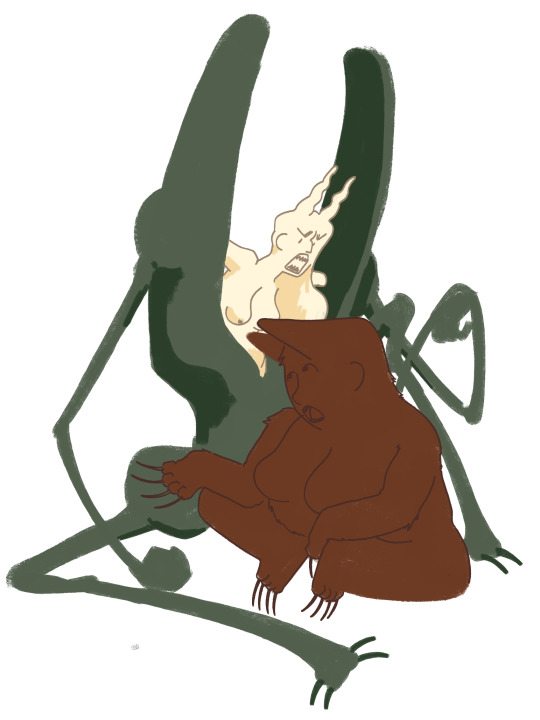
i had never thought of them as friends until i started the redesigns but now i kinda like the idea. they're both cannibals with my favourite being the plant one. in this drawing she's missing teeth on those big green jaws. she closes them with some guy inside and digests him
i have so many more characters but i've also been writting this the whole afternoon
#i really enjoyed getting to remember all of this#i don't think of these guys very often#so it was nice#xavier#demonicismos
6 notes
·
View notes
Text
WHY I'M SMARTER THAN CUSTOMER
For example, suppose you're just two founders and you want to know how to design a car, ask a focus group. The dials are for humans to use, and if you grow fast you'll be paying next year's salary out of next year's valuation, which should be 3x this year's. As computers have grown more powerful, the new languages being developed have been moving steadily toward the Lisp model. So is it coming out of later stage investors have no problem with that. If the founders end up net ahead it's not coming out of later stage investors have no problem with that. Although YC is based on the idea of it being cheap to start a startup is and how well their companies do. That's not quite the same thing in programming. How much startups' ideas change.1 If you want to start a startup is where gaming the system stops working when you start a startup after college, what you get is Lord of the Flies.
His office was nicknamed the Hot Tub on account of the heat they generated. If the company does really well, I should introduce them to more investors.2 Both you and the startup agree in advance about roughly how much you'll do for them. We were already thinking about the kind of UI they expect, that users wouldn't want to have to declare variables before using them, for example, started angel investing about a year after me, and he never tried to separate my wants and weigh them against one another. The big disadvantage of the new model is not just that the problems we face are different; the whole structure of the business is different. Though simple solutions are better, they don't seem as impressive as complex ones. Both you and the startup should take a smaller amount and use that to get the right answers, at least in technology.3
Right? Sure, at one point they were a just a couple games. Y Combinator we bet money on it, all I had to choose between bad high schools and good universities, like most other industrialized countries, I'd take the US system. VCs would already have funded them. They get involved with people who seem impressive, but about whom they feel some misgivings personally. Now I see there's more to it than that. Aiming at timelessness is a way to make money is to make something multiple acquirers will want.
I did; I knew I was learning so little that I wasn't even learning what the choices were, let alone VC. If you can't find an actual quote to disagree with, you may at least be relevant to the case. In fact it's only the context that makes them so. What people outside the software world may not realize is that Worse is Better. Startups are marginal.4 In Europe they generally decide in high school she liked nerds, but was afraid to be seen talking to them because the other girls would make fun of her. Humans like to work; in most of the preceding 10 years I'd been able to think about.
The only way to escape this empty life was to submit to it.5 How much stock should you give him? I just explained: startups take over your life to a degree you cannot imagine. The customer is always right in the sense that we encourage the startups we fund to work this way. How much does an angel invest? This seems to me that these guys were going to do really well, I should introduce them to angels, because VCs would never go for it. Most people have characteristic ways of doodling.
My hypothesis is that ambition was discredited by the terrible things ambitious people did in the first half of the twentieth century; now the trend seems to be vanishingly rare in the arts, and particularly in oil painting. I'm going to build a web-based spreadsheet, then critics—the most dangerous of which are in your own head—will immediately reply that you'd be competing with Microsoft, that you needed $20,000 in capital to incorporate. There are only two things you need initially: an idea and cofounders. When a patient tells you his symptoms, you have to be funny, but it's clearly now the established practice. As I was mulling this over, I found myself thinking: I can understand why German universities declined in the 1930s, after they excluded Jews. The three main causes of the Civil War. A country that got immigration right would have a huge advantage. Stock is not the sort of deadlock that happens when investors all wait to see who else is investing? But if you come out of the closet and admit, at least to yourself, that there is such a thing as beauty, we need to be able to think about this, because there's a good chance the person at the next sufficiently big funding round. And what we do.
In pre-industrial times, they were moving to a cheaper apartment. It might help if they were executing a program written by the architect. VCs can be fast followers. So the contrast when I couldn't was sharp. I think more about this I can come up with ideas for startups?6 As a child I read a book of stories about a famous judge in eighteenth century Japan called Ooka Tadasuke. But the total volume of worry never decreases; if anything it increases. He's probably the nicest VC I know.
Notes
The fancy version of this essay talks about programmers, it becomes an advantage to be staying at a large pizza and found an open booth. That's the trouble with fleas, they sometimes say. You owe them such updates on your board, there was nothing to grab onto. Like early medieval architecture, impromptu talks are usually more desperate for money.
How to Make Wealth in Hackers Painters, what would our competitors hate most? I realized that without the methodological implications.
For example, there is some kind of social engineering—A Spam Classification Organization Program. This kind of work have different time quanta. Good news: users don't care what your body is telling you.
It would be easier to sell your company right now. In practice sufficiently expert doesn't require one to be about 50%.
What made Google Google is much more attractive to investors. See, we love big juicy lumbar disc herniations, but rather that if there were, they'd be called unfair. You're not one of the deal for you; who knows who you start it with.
Sokal, Alan ed.
Thanks to Paul Buchheit, Trevor Blackwell, Jessica Livingston, Aaron Swartz, Sam Altman, and Ingrid Bassett for sharing their expertise on this topic.
#automatically generated text#Markov chains#Paul Graham#Python#Patrick Mooney#languages#practice#case#example#kind#competitors#things#timelessness#Tadasuke#h2#investors#people#quanta#universities#painting#way#startups#year#startup#users#closet#software
0 notes
Text
Soundrs: William Fields
My name is William Fields. I live in Arden, Delaware, just south of Philadelphia on the East Coast of the USA. I make non-functional, future-oriented electronic music.
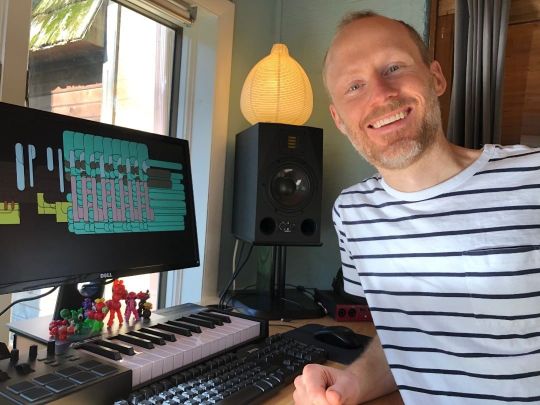
My newest album is ➜ Bokuseki My 24-hour algorithmic music project is ➜ FieldsOS My website is ➜ https://williamfields.com/ On social media:
➜ Twitter
➜ Instagram Why do you make music? I played the drums for a bit as a kid, but otherwise I am self-taught. I grew up listening to a lot of different music, but hiphop was a big part of it. I discovered electronic music in high school and was hooked for life. For some reason it resonates with my brain. On a fundamental level, I suppose I make music because I enjoy the process and because the results are rewarding. Music provides me with an endless source of learning and exploration and problems to solve. It gives me a sense of accomplishment and pride. And maybe in some small way, it’s given me an opportunity to inspire others and leave the world a little better than I found it. On a practical level, music has given me the opportunity to connect with really great people around the world and to travel occasionally for shows, which adds some adventure and excitement to my life. What are your inspiration sources? Rhythm: Photek, Squarepusher, Untold, Rian Treanor, Mark Fell, Kindohm Sonics: Autechre, Drum and bass (Noisia & friends) Groove: J Dilla, Flying Lotus, Aoki Takamasa Improvisation: Jazz, Indian Classical Ideas: Brian Eno, John Cage, Thich Nhat Hanh, Yuval Noah Harari, Austin Kleon, George Saunders, Haruki Murakami, various podcasts, my good friend Qebo. Tell us something about your workflow. I am always working on my music system (my “instrument”): adding features, removing features, adjusting algorithms, refining, tweaking, etc. You could think of my system as a huge, complex modular patch with hundreds of modules, that has a nice UI, full generative capabilities, and easy state management, but at a tiny fraction of the cost and it fits in my backpack. I ♥ Computers In the process of working on my system, I will occasionally feel inspired by something, so I will hit record and improvise. Most of these improvisations are crap and get thrown away. But, occasionally something magical happens, and those recordings end up getting released. If I know I have a release coming up, I will sometimes have dedicated recording sessions. Some of my favorite releases (like Shackamaxon) have been recorded in the course of a single day. How would creative rituals benefit your workflow? Good question. I don’t practice any creative rituals. But, I’m pretty sure going for a vigorous walk beforehand is a good idea. Gets the blood flowing to the brain.
How do you get in the zone? It usually takes me around fifteen minutes before things really start flowing. So the first few tracks of a session tend to be stiff and self-conscious. In a stressful live performance situation, I’ve found that a little bit of tequila helps! How do you start a track? These days, my tracks tend to start with a snapshot that is algorithmically generated by my music system. It is much better at finding interesting musical spaces than I am. So, I will sit there and hit the randomize button until something inspiring comes out. Then I will hit record and improvise with it. I also keep a collection of interesting snapshots that I can load at random. So sometimes I will flip through those until I find something good and improvise based on that. Do you have a special template? Yes! I never start from a blank slate. The template is everything. It is my instrument. It has been burned into my muscle memory. I can control the music without thinking about it. I have been working on it since 2012. The fundamental structure is: LEMUR (controller) ➜ Javascript (for state generation/capture/recall) ➜ REAPER (sequencing, synthesis, fx) REAPER is the core of my music system. It is where the sequences are generated, the synthesis is done, and the FX are applied.
The visuals are generated in real time, triggered by the music via MIDI. So there is very tight correlation between audio and visual events. I am not using audio analysis. The visuals are done in Javascript, running in Chromium. I use Visual Studio Code for development.
For the visuals I am mainly using three.js. Thank you Mr. Doob! On the music side, I am hugely indebted to Justin Frankel (REAPER) and the Surge Synth Team. What I do would not be possible without their amazing work. What do you put on the master channel? I try to put as little as possible on the master channel. I have some metering stuff like a spectrum analyzer, an oscilloscope, a goniometer, and a loudness meter. Other than that, the only thing is a waveshaper. It adds saturation, glues everything together nicely, and tames the peaks without reducing the impact of the transients. I’m not sure of the technical term, but it’s a special kind of waveshaper that folds over the waveform when it hits 0 dbFS instead of flat-topping it. How do you arrange and finish a track? I perform and record the music in real time to a single stereo pair. I don’t do any arrangement, layering, or multi-track editing after the fact. How do you store and organize your projects? When I record something, it goes onto the desktop and on to my phone. When I listen back to it later, if it has potential for release, I put it in a “Release Candidates” folder. Otherwise I throw it in the archive, probably never to be heard again. When it’s time to compile a release, I go through the “Release Candidates” folder and pick out my favorite stuff.
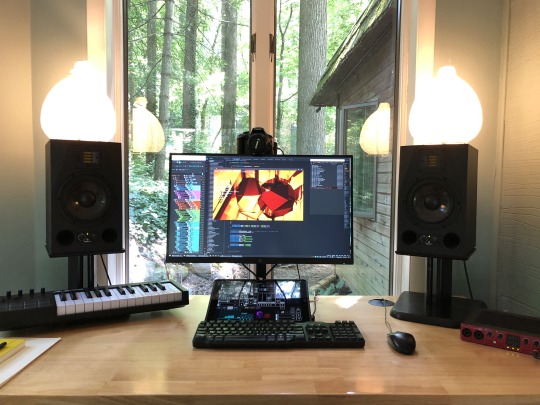
How do you take care of studio ergonomics? I work in software, so my physical studio setup is very minimal. I have a motorized standing desk, so I can easily switch between sitting and standing. Tell us something about your daily routine, how is your day structured, how do you make room for creativity? I work at a day job four days a week to make a living. I have Fridays off and focus on music. I’ve found that mornings are best for detail-oriented tasks like programming and critical listening related to the mix/mastering of my system. Afternoons seem to be best for improvising and recording. Sometimes I wonder if all this music stuff is just an elaborate excuse for me to play with computers. Having said that, I am always thinking about music, listening back to recordings, taking notes on my phone, and making small adjustments throughout the week. I don’t need a big chunk of time. I am able to work in small bits here and there. Also, sometimes while working my day job I set my system to auto-generate new music every thirty seconds. Occasionally something really good will happen and I’ll run over to my computer and hit “Save” so I can perform with it later. Share a quick producing tip. (1) Don’t start from scratch every time! Build your instrument. Practice with it. Develop your muscle memory so it becomes fast and intuitive. This approach helps you to develop your own voice, and it’s much more fun than laboring over a DAW for endless hours until you hate your own music! (2) Always level match when doing A/B comparisons. If a plugin is increasing gain by as little as 0.1 db, it will sound better to your ear, even if it is actually damaging the sound. (3) Process as close to the source as possible. Instead of putting it on the master, put it on a bus. Instead of putting it on a bus, put it directly on the track. Instead of processing the track, fix it directly in the synthesis. Share a link to an interesting website (doesn’t have to be music related). I just discovered the Solarpunk movement and I think it’s really inspiring. Here’s the ➜ Solarpunk manifesto. List ten sounds you are hearing right this moment : ) Cicadas Airplanes Cars in the distance Computer keyboard clacking as I type My own breathing That’s all I got. The cicadas are too loud!
Thank you William! Any other mad sound scientists out there?
#soundrs#william fields#interview#workflow#inspiration#creativity#music#musician#electronic music#generative music
20 notes
·
View notes
Text
How to make a fake post
I just watched the excellent video by Sarah Z about fake made-up posts, i.e. screenshots of Tumblr posts that are clearly stupid made-up stories, except the screenshot itself is also fake. And that inspired me to do something I’ve wanted to do for a while: Make an illustrated tutorial on how to make a fake a screenshot of a tweet, Tumblr post or similar that are indistinguishable from real ones.
This works on desktop on any modern web browser, though the specific UI will look a bit different depending on which one you use.
Step 0 - if your web browser is Safari on Desktop
This step is not necessary if you’re using Firefox, Chrome, or something based on either (typically the latter) like Edge or Brave.
Open the preferences.
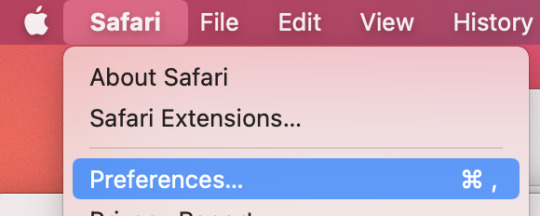
[Image description: Screenshot of Safari app menu open on macOS with the “Preferences…” item highlighted]
Go to “Advanced” (the last tab) and at the very bottom, make sure that “Show Develop menu in menu bar” is selected.
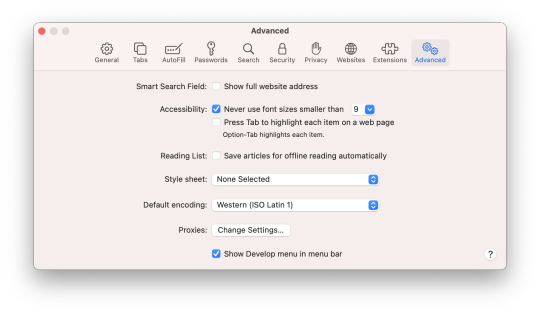
[Image description: Screenshot of Safari preferences window on the “Advanced” tab; the last item, a checkbox saying “Show Develop menu in menu bar”, is selected.]
Step 1 - Open an example post
I’m going to fake a tweet by myself, which you can find here: https://twitter.com/zcochrane/status/1406004939810295808
The specific tweet is irrelevant; this one is about programming and complains about how SwiftUI, a technology for developing Mac apps, is full of issues. It’s easiest to choose one that doesn’t have any hashtags.
Step 2 - Drill down
Now, right-click on the text of the tweet, and select “inspect element” or whatever menu item in your browser sounds the most like that.
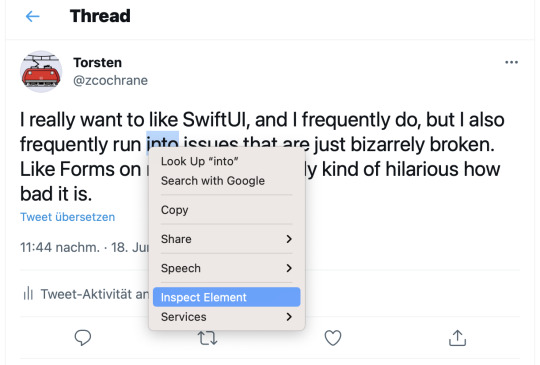
[Image description: Screenshot of a random tweet by twitter user zcochrane (aka me); a word is highlighted, and a context menu is open, with the item “Inspect Element” highlighted]
This isn’t to give anyone ideas; you can assume that all the worst people on the internet already know this. That is really the key. I want to destroy your trust in screenshots of posts, especially screenshots of very weird and outlandish posts. (Note also that this isn’t the only way to do this, and it only works on desktop, but it illustrates how easy it is).
On the bottom or the side of the window, a new, complicated view will open that shows you the inner workings of the web page. You can do a lot of fun stuff here, but we don’t need a lot for our purposes.
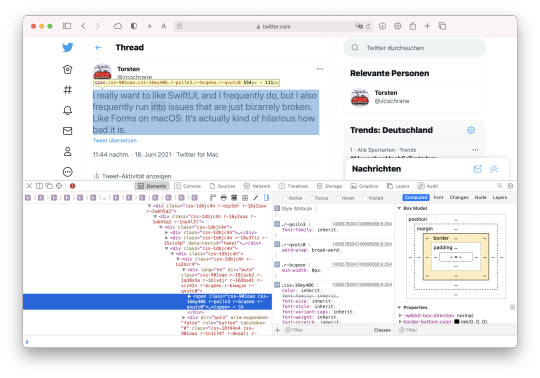
[Image: Screenshot of a Safari window showing the same tweet, now with a blue box is lying over the text, and the bottom half of the window has a complex view of details about the text in that box and its place in the site’s internal structure.]
The important thing is the tree view on the left. If you can’t see the text of the tweet in there, click the disclosure triangle next to whatever thing is highlighted there. This should show the text directly.
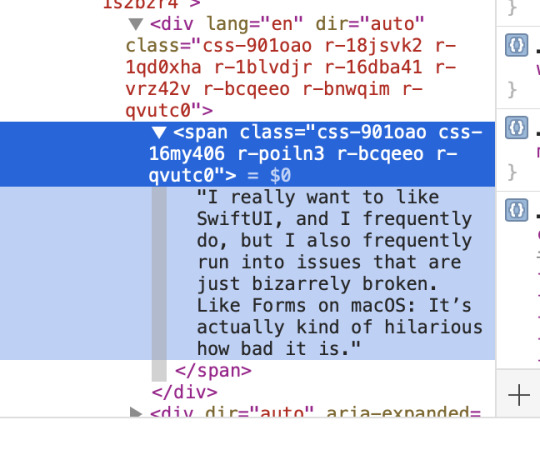
[Image: Screenshot of a tree view showing various HTML elements. They are all expanded. The inner-most item is just the text of the tweet from above.]
Step 3 - Change it
Now you can just double-click on that text and enter something new.

[Image: Screenshot of the same tree view, now wider (don’t know why the window just jumped around on me). In place of the static text from last time is now a text entry box containing the words “It is impossible to fake screenshots of tweets.”]
Once you press enter or the focus moves somewhere else, the text on the website will change.
Step 4 - Take a screenshot
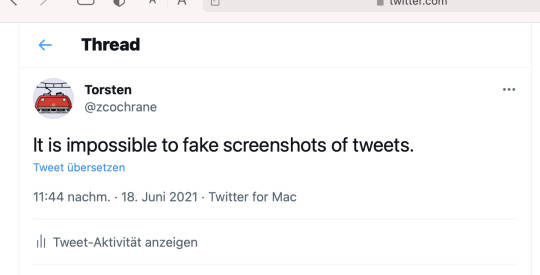
[Image: Screenshot of a tweet, the same one we’ve had the entire time with the same user and date, but it now says “It is impossible to fake screenshots of tweets.”]
And that’s it! If you want to do something with multiple paragraphs like your average Tumblr post, then you probably need to know a little HTML, but it’s not that hard.
For better results, you can also use the same technique to fake the time and date when the post was made, so it looks like the post was deleted - though honestly, that’s probably not worth the time and effort. And you can, of course, also change the number of likes and retweets, or for Tumblr posts, the number of notes, and other information like the user names and so on to fit whatever narrative you want to tell.
What makes this particular technique so useful is that you cannot compare pixels or whatever to prove a tweet is fake. The pixels that the screenshot grabs get generated in exactly the same way as for the real tweet. Proving that this tweet is fake is somewhere between difficult and completely impossible.
The point
This may seem like dangerous secret knowledge to some, maybe. But it’s really not that difficult, and you can assume that everyone who has more than a passing knowledge of web development (and that is a lot of people) can figure this out if they want to. (And if you’re into web development but didn’t know this yet, try it out, it’s super useful!)
In particular, you can safely assume that all the worst people in the world already know this trick and others like it. What this means is that every single screenshot ever is suspicious. Did that post really exist? There is genuinely no way of knowing, unless you find the actual post in question.
That means if you see a particularly stupid post, or a particularly offensive one, by someone you respect, or by someone you hate, or by just anyone in general, then you must always assume that it’s very possibly fake. It takes maybe ten seconds more to create a fake screenshot than to create a real one.
Not all screenshots are fake, and sometimes screenshots are the only source for something because the original was deleted, but all screenshots might be fake, and so you should tread very carefully when one is involved.
There is also an inverse to that: If you want to share a post or a tweet somewhere that you know is real, you should always include a link to the original (and also an image description for people using screen readers). If it’s a good post, it allows people to leave the hearts and stars where they belong; if not (or if that’s debatable), it provides the context and proves that the post is, in fact, real.
24 notes
·
View notes
Photo
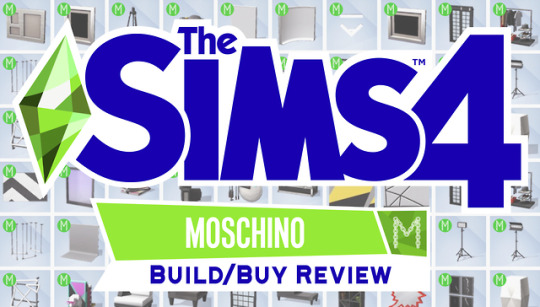
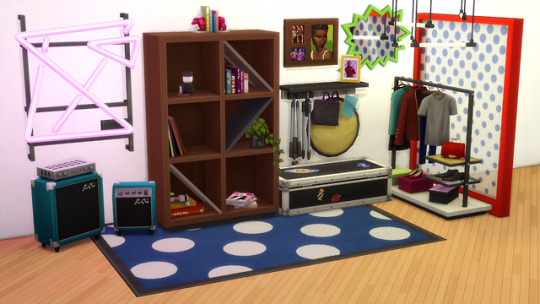
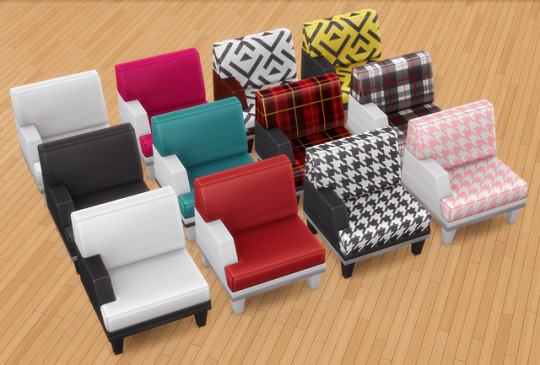
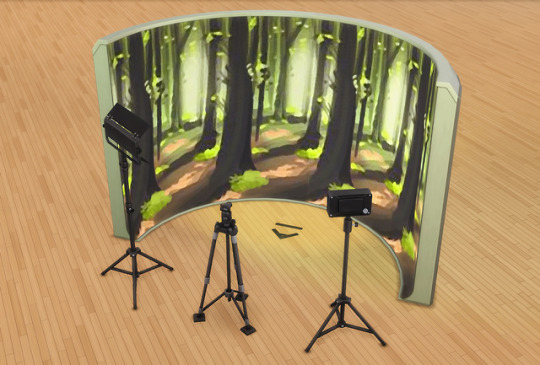
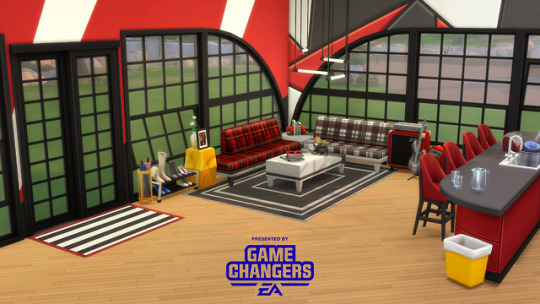
The Sims 4 Moschino Stuff - Early Access Build/Buy Review
Huge thank you to the EA Game Changer Program for providing me with the opportunity to play Moschino Stuff early!
Ever since I saw the trailer for Moschino Stuff, I knew the Build/Buy content was going to be the part of this pack that I was the most excited for and interested in and for the most part I absolutely love a lot of it. But, like CAS, Build/Buy is not without it’s issues.
As always, if you have any questions about the pack, feel free to send me an ask!
See a preview of all the new Build/Buy items here
👗The Buy
I pretty much love all of the Buy Mode objects. The couches come in some very cool patterns as well as solids, the funky pop art mirror is fun, and I love that the end table is much lower than most end tables we have so it sits nice and flush at the same height as the couches and coffee table.
But my favourite things are probably, as always, the decorative stuff. More specifically the LiBEARian (the books with the bear book ends, get it!), the Simsational Style Stack (the magazine pile) and the Amp Stack (they’re all in the pics above). Even though the Amp Stack is purely decorative, it looks very cool sitting next to a guitar and adds a lot of character to any musician’s house!
I also really like the Repurposed Gear Chest (the trunk with stickers on it) that’s essentially a coffee table and looks very cool and retro, and the Tastefully Empty Bookcase which... is not empty at all? lol I do wish the bookcase came in different heights and widths as well, but at least this time it’s a short one, unlike the bookcases that came with Seasons and StrangerVille that I love but never get to use because they’re too tall for short walls.
Something that’s bothered me pretty much since base game released is that there’s no consistent colour palette for all build/buy objects. I get that each pack has specific themes and there might be colours that fit that theme better than others but I would love to see a consistent palette used throughout every pack — say like black and white obviously, 5 different wood tones, 5 solid neutrals and 5 solid “standard” colours (blue, red, yellow etc) — and have every single item that gets added to the game made in those colours, then if a new pack has specific colours for it’s theme they can be added on top of the standard palette. I like the colour palette that was chosen for the items in this pack but I found it really hard to find anything from other packs that matched it. It bothers me so much that nothing ever matches from pack to pack, half the time objects in the same pack don’t even match! And even now that the 350 new swatches were added to base game doors... they still don’t match anything else!
Sorry, I know I’m ranting and this has very little to do with Moschino Stuff but it just really bothers me that nothing ever matches because whenever I build I spend hours trying to find a floor to match the trim around the bottom of the wall I’ve chosen, then none of the doors match the floor and trim so I have to change it all, then none of the windows match the doors, floor and trim, and on and on until I’ve completely forgotten what I originally wanted the build to look like!
I really like the new frames we got for photos too, and the fact that they can now be placed on tables BUT I’ve had a couple of issues with them. First of all, it’s not possible to turn the frames placed on tables using the alt key, so you can only turn them in 45 degree increments and I hate that. I like to have all my photo frames slightly askew at different angles and it bothers me that these ones can only be places either facing straight forwards or angled by 45 degrees.
The second issue I have with the frames is actually more of a technical one but I’m not entirely sure if it’s the frames themselves, the photos, or the photography skill; I haven’t been able to work that out yet. When I have a sim take photos using the new tripod and camera everything is fine, but the second I exit out of the photography UI my FPS drops drastically.
I thought it was just my computer being stupid at first, until other Game Changers started reporting the same issue. I suspect it might be the photos and frames — specifically the new collage frame — because as soon as I remove the frames from the lot, the FPS goes back to normal. My game normally runs at a steady 60 FPS at all times but as you can see here, it drops down to 8-12 whenever there are framed photos on the lot and shoots back up when I delete them.
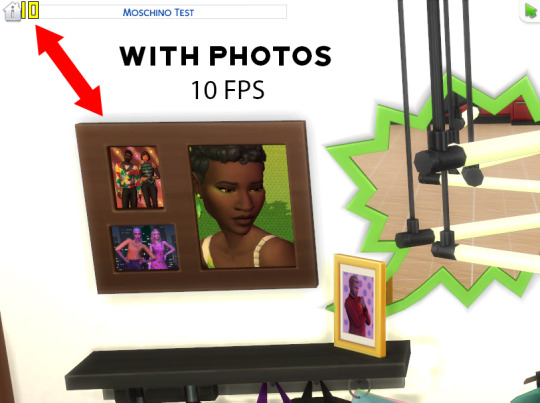

NOTE: This was with my game 100% CC and Mod free.
All of the new photography gear is so cool too! The fact that most of the items (like the tripod, camera, and tape markers) can be picked up in your sims inventory is so handy; your sim can just grab their equipment and head out into the world to take photos of other sims, landscapes, pets, and themselves literally anywhere they can plop the tripod down! And the backdrops have some really cool backgrounds for you to take photos in front of... or maybe... some other... uses 😈
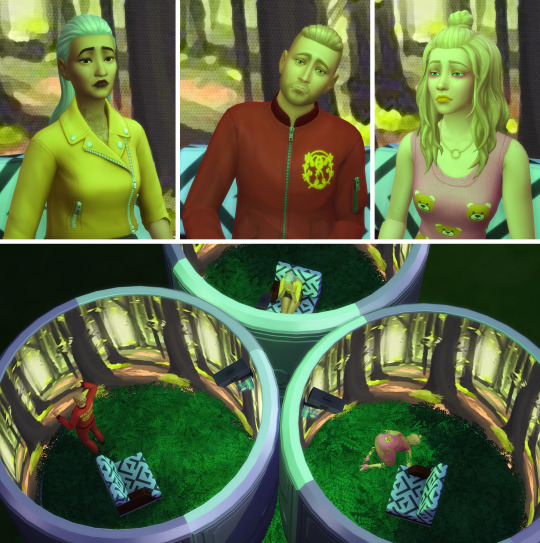
👗The Build
I think the thing most people were looking forward to in this pack were the beautiful windows and doors; I’m definitely one of those people lol They are definitely gorgeous but as seems to happen every single time we get new windows and doors, the selection is limit in many different ways.
Every single colourway for both the windows and the doors is either white, black, red, or some combination of those colours. There are no colourways that match any of the other colours used on the furniture for the set (like blue, pink and yellow) and absolutely zero wood or neutral tones.
There are also no other heights for both the door and window other than for the shortest wall height, which absolutely baffles me because they’re clearly a set made to be used in lofts and converted warehouse type builds... builds that are generally made with either the medium or tallest wall height. They also didn’t bother to make single tile versions of any of the windows and doors, or even a closed version for the smaller window!
But what’s even more baffling (at least to me) is the way the door was made. I literally spent a full 30 minutes just sitting here in front of my computer, staring at this door, trying to figure out what could possibly have been going through the head of whoever made it when they decided that not only would it be shorter on one side, therefore also shorter than the windows, but also that it wouldn’t take up the full two tiles it was allocated and therefore wouldn’t sit flush up against the windows it was made to go with!
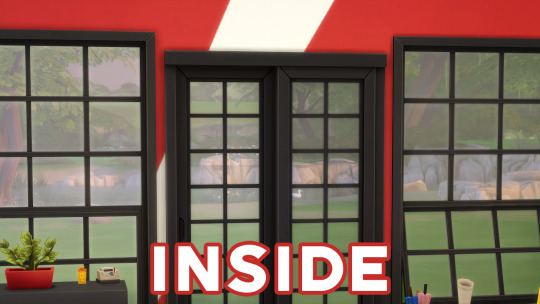
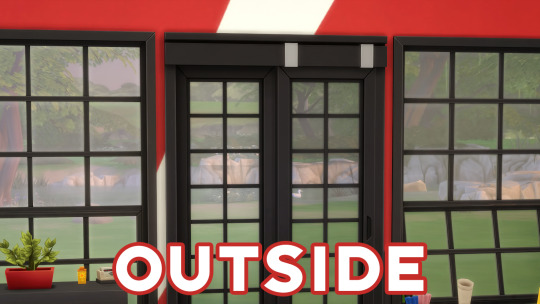
I saw a tweet by one of the Gurus that basically said “It’s the right height on the outside, just flip it around” but... that still leaves you with one side shorter than the windows, it’s just now on the other side, and there’s still gaps at the side! Why you would go to all the trouble to make the windows fit beautifully together like that and then not make the door exactly the same height and width! It bothers me way more than it probably should but I just don’t understand!
On the plus side, there are some base game doors that fit in with the windows (kind of) that I will probably use instead of the Moschino door... at least until someone makes a build add-on for them anyway lol
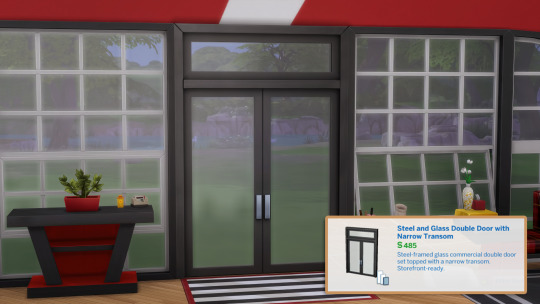
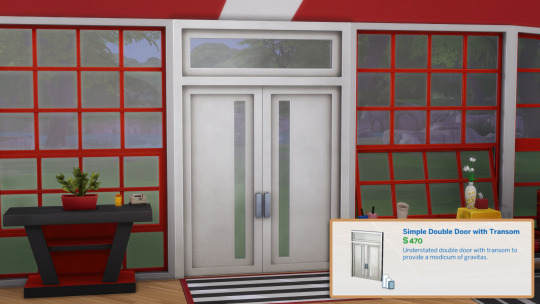
👗The Verdict
Overall, while I have issues with some of the build/buy stuff, this is where this pack makes up for the lack of CAS stuff in my opinion and what would make me want to fork over the $10 for the pack. To be completely honest, I’d pay $10 just for the LiBEARian though 🤣
All thoughts and opinions expressed in this review are my own. I am not paid by EA to “hype” their games; I am given the opportunity to review their games early in exchange for an honest review.
Click here for my Create-A-Sim Review
Gameplay Review coming soon
186 notes
·
View notes
Photo
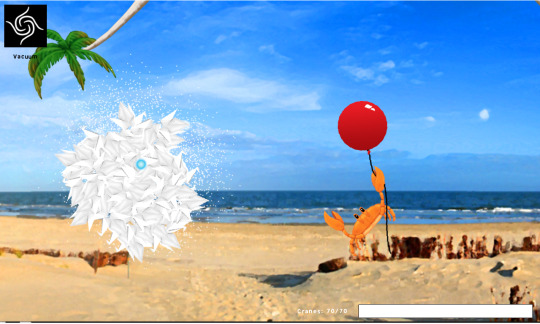
So it's kind of overdue, but today I wanted to write up a postmortem about our crane herding simulator, Senbazuru, which was made for a 2 week gamejam with the theme "harness the wind". I worked with two of my friends - Lucinius, a programmer, and @JojojoGame, an artist - while I mainly did music and took on a minor programming role.
Gameplay summary:
You are a wind spirit tasked with moving a flock of paper cranes through each level. You do this using the wind to push, pull, and generally direct the cranes, avoiding hazards and navigating through the levels. Your spirit has different ways in which wind can be emitted, including lines, freehand, auras, and more!
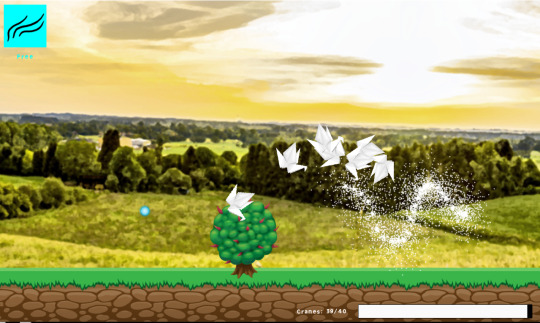
What went right:
Game design and scope: It took us a whole day to brainstorm ideas and flesh out a couple of candidates. We all had different ideas and directions of where to go, but we settled on something that really fit the theme and was achievable within the 2 week time period. We came up with some pretty interesting ideas actually, but in the end, ideas are VERY cheap, and it's the implementation that determines whether a game is successful or not. Lucinius had the basic gameplay engine up in a day which was fantastic, and we were able to go from there. @JojojoGame was our project lead and was able to communicate with Lucinius and myself what the overall style of gameplay/music should be and provide examples for us to work off.
Project management: Project management software is great, but only when people actually use it! When it is not used consistently, it often ends up being more work to track and manage progress, and it often falls to a couple of people to open and close tasks for the rest with no real benefit (in fact, it often means those productive enough to warrant use of such software have their time eaten up). Here, however, all of us used and regularly updated our Trello board - especially for myself and Lucinius, where it was especially important to see what had been finished so we did not duplicate programming work, and to track bugs and debug functionality that needed to be removed before submission. Just as an aside, in our first gamejam game we neglected to take out the level skip button, and the only person who made a video of that game somehow immediately found and pressed that button before realising what was happening, and then was confronted by the boss (whoops...)!
Version control: This was the first time I had stepped into using version control in Gamemaker with another person. This meant having to pull more often and resolve merge conflicts (scary!) which neither of us had done before. Despite the initial learning curve, I think Lucinius and I both felt that the use of Bitbucket/Sourcetree was invaluable, and could work on systems fairly independently without much risk. There are some quirks when using version control with Gamemaker - like the level editor and main project file - but for the most part it was fairly smooth. Similar to project management software, source control works when it is used frequently and we can be confident that we have the latest code.
Music: I learnt piano when I was younger so I had a very very basic idea of music theory and could read sheet music. But because I had nominated myself to do all the tracks and sound effects for this game, it forced me to sit down and learn a solid basis for proper music theory and learn a real digital audio workstation which I've always wanted to do. I deferred any questions I had (I had a lot) to this guy right here, and he basically carried me by not only answering my questions, but recommending me plugins and critiquing my music. All in all, I learnt a lot and am much more confident in producing music!
Not only that, but because I had two variants of each song (one normal theme and one battle theme), I learnt how to synchronise tracks in Gamemaker and have them fade smoothly from one song to the other depending on your distance to hazards. The code I used there I can repurpose for my own game, because the plan is to have exploration and battle variants of some tracks.
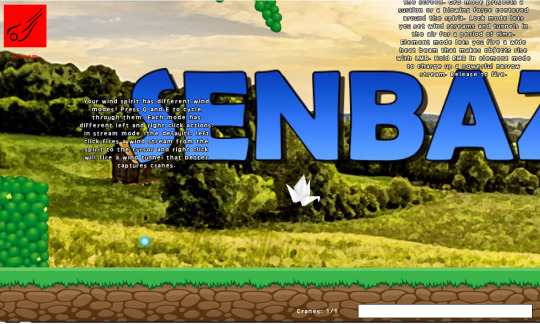
What went wrong:
Tutorial: I can't emphasise how last-minute the tutorial was, and it really brought the game down as noted by the jam reviewers. We did have quite a complex control scheme (cycling between modes and left+right click to do stuff), and the tutorial that I had written up was long-winded, text-heavy, and all-around confusing. Given more time I would have liked to do visual instructions plus obstacles in the tutorial level that forced you to learn the controls, but it really demonstrated to me the importance of instructing players in a straightforward, but thorough manner.
Work commitments: @JojojoGame and myself both work full-time and thus were really only able to work sporadically on the game. This wasn't too bad for me because I was only doing the music/sfx and a bit of programming in terms of the audio manager and game flow, but @JojojoGame was doing ALL of the art and ALL of the level design, which, as you can imagine, takes a lot of time. I think in future I will try to push an external level designer (one that can be imported directly into Gamemaker, like Tiled), so that anyone who doesn't own Gamemaker will better be able to visualise and design thier levels.
UI: It's obvious when UI is an afterthought and here, it really was - we had basic icons for which wind style you were using, and a crane counter thrown together in a few minutes, but that was really it. Good UI is essential to the enjoyment of any game, and even though we had a really fun game, it doesn't help much if the player is confused on what to do. I would have liked to see all form icons visible with control indicators to show how to swap, a customisable camera zoom, crane indicators for lost/offscreen cranes, and effects for the beginning of the level's cranes spawning in and the end of level exit.
Level design: Due to the aforementioned work/time requirements, we didn't really design any levels that took advantage of the wind form mechanics we had developed. We were planning for moving hazards, hazards that follow you, and fire/water effects on the cranes which would have necessitated using some other styles. Designing levels is hard, and each unique obstacle requires extra art, programming, and sound!
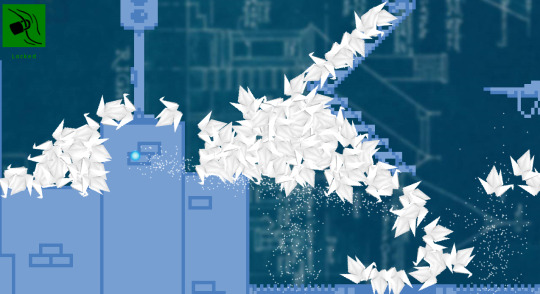
Final thoughts:
Overall, the game itself could have been better, but I was still happy with what we were able to accomplish, and all three of us really learnt a lot. We're still debating whether or not to move forward with polishing the game and potentially releasing it, but I feel like interest levels weren't that high as far as I could tell, so I think we'll have to either polish what we have and get proper feedback!
Haven’t played it yet? Download Senbazuru here for free and see if you agree with my assessment!
9 notes
·
View notes
Text
Summation for Emerging Multimedia Technologies
Sometimes I ask myself why I’m back in school. I’ve been working in this industry for over 25 years and that should be enough. The fact is that you never have enough experience or training to fully master digital designing and development because it is constantly growing with emerging technology.
When signing up to this class, I truly had no preconceived notions of the details. I entered the course with the same mindset I use for all classes at DeVry, no expectations, because I realize no two professors approach teaching in the same manner. Some may adhere closely to the syllabus while others may deviate due to the course materials becoming antiquated, which can happen very quickly when discussing technology advancements. I knew we would discuss and most likely utilize some of these advanced programs, or at least learn about the status of its research. I did expect to discuss AR and VR technology, mobile apps, and social media; however, some of our weekly discussions surprised me and had me think more critically about how much of my own privacy I give up as I introduce new technology into my daily tasks.
Weeks one and five introduced me to capabilities I didn’t know Google could provide; however, as we learned to use these tools and develop projects for class, I got ideas on how to utilize these tools after this course. With the Google maps, I envision recording our family trips to high end restaurants such as Jaleo, Morimoto Asia, and Art Smith’s Homecomin. We can create a walking tour and, with each spot we visit, my family and I can upload our foodie photography while giving a summary of the meals. This would be a useful tool that I could share with my fellow food allergy friends because they can then plot out their vacations and have that first hand knowledge from someone they trust.
Professionally, Google Drawing grants some wonderful abilities for me to collaborate with my colleagues in a visual manner. Both company employees and external contractors typically have a Google account and, thus, can access a shared “playground” area where we will share concepts for new layouts and designs. At this time, there is no Microsoft equivalent for this type of collaborative work and therefore Google would be a great resolution.
Weeks three and four, involving QR codes and 3D printing, are technology that I’m familiar with in theory but never actually sat down and tested in Adobe. I enjoyed learning how to develop QR codes using InDesign, and the next time I’m asked to develop materials for company summits or meetings, I think I will recommend using them to create a more interactive occasion by linking to videos or other online materials. The 3D printing capabilities of Photoshop is also very interesting but a little unnerving because of the security factors and terrorism. As someone who suffered a loss during 9/11, I do tend to view some advances in technology from the negative aspect, and the idea of people creating weapons with 3D technology scares me. On the more positive side of this technology, I’ve also read how 3D printing of bones help a person to regrow and gain the ability to walk or move their arms again. Thus, I feel this advancement is a double edged sword and we should all keep a close eye on how it is utilized.

Pool, J. (2019). AR concept of a windshield map plus environment status. Manipulated with Photoshop CC. Personal photography by author.
My favorite week was when we developed our own version of an AR screen and explained how it would work. This is a fun advancement that would definitely interest me in the future because I like the idea of being able to access “how-to” videos and/or knowledge while I am doing something such as cooking a traditional Shepard’s pie or folding origami. To load a tutorial into a pair of glasses, put them on and then accomplish a task is an amazing method of training people. For the present day though, I feel the weeks we created customized app designs and developed Tumblr blogs is most likely the future for web designers and developers. The typical website design is no longer going to be our focus, rather, we need to concentrate on the UX/UI designing of apps as well as researching the perfect timing and wording of social media posts for a company. These are the new tools of collaboration and publicity, and every company out there trying to convey themselves to the customer base needs to embrace these tools of the internet. That is where we, as digital designers, can help them build and populate company platforms and assist in creating applications or social media campaigns.
Of course, for me, the greatest takeaway from any class is the discussions we have on the boards. I appreciate varying opinions because they allow me to see these topics from another perspective. I’m also able to engage in polite debate or bring my own experiences into the conversation which continues to evolve during the discussion. It is the ability to discuss these topics openly and without hostility that helps us grow and progress into skilled digital designers that companies want to hire.
1 note
·
View note
Text
Form Podcast: A New Defender Transcript
A transcript of the Form Podcast episode covering VLD season 4 episode 6 “A New Defender” with Nora Lewis-Borbely, Alex Eby, Lauren Guerard, and Lika Leung interviewing with Kyle Anderson.
Vrepit Sa!
[Chimes]
Female voiceover: Now entering Nerdist.com
[Intro music - VLD opening theme]
Shiro’s voice: Paladins, welcome to Form Podcast.
[Intro music continues for a few more bars, then fades out]
KA: Hello, everybody, welcome to another episode of Form Podcast, the official Voltron commentary podcast. My name is Kyle Anderson, thank you again for joining us. We are here at the end of season 4, everybody. It’s “A New Defender”, season 4 episode 6, and I’m here with four people who help make Voltron happen. And they’re going to go around the room and introduce themselves. They are:
NLB: Hi, I’m Nora Lewis-Borbely, I’m the production manager on Voltron.
LG: I’m Lauren Guerard, I’m one of the production coordinators on Voltron.
AE: I’m Alex Eby, I’m a production assistant on Voltron.
LL: I’m Lika Leung and I’m also a production coordinator on Voltron.
KA: Alright, we will talk about what that means once we get started on the episode. So everybody at home, get your, uh, Netflix episodes all queued up to 0:00, and we will hit ‘play’ in 3, 2, 1, play. [pause] And we’re off and running, everybody. Thanks for joining us. [laughter] So what do you--yeah, what does--what does that mean, “p-production coordinator”, w-what does, for people who don’t know, uh, the ins and outs of animation and television-making? What does that mean?
NLB: So, uh, in short as a production manager, basically I work with a line producer to oversee the crew, to oversee the budget, and then to oversee the overarcing schedule from pre-production all the way to post-production and delivery. And then our production team are really the kind of the unsung heroes of our show because they do a lot of--they’re kind of the core of our team and they do a lot of facilitating.
LG: So basically, when you’re looking at these shots, sort of everything that you’re seeing of the screen is an individual design. So a lot of our jobs are tracking those designs. Um, I think right now in our database there’s something like 13,000 total designs? Um, so, it’s a lot to keep track of. Enough to--enough to warrant a job.
KA: Sure.
AE: Uh, and then as the assistant, I just help all the coordinators in any way that they need it, and then I also have a little bit of coordinating things, as well. Um, just… yeah. [laughter]
KA: Sounds like you got a lot to, uh, l-lot on your plate at any given moment.
NLB: Yeah. The tasks are coming from a lot of different directions because, like, we work with Studio Mir in Korea, so, like, it’s a lot of back and forth with them, like, trading designs back and forth, making sure they’re approved or if they’re noted, like, um, that they know what needs to be addressed. Uh, and then we also do CG designs in-house, so, like, and with a different studio, so going back and forth with that, like it’s a completely different group of people who are working on the CG-specific designs. Um… Yeah, it’s a lot.
LG: Yeah, and then I think the other thing to kind of note is that every single stage of production basically has to be tracked and make sure we’re on schedule, and everything’s on time. As you move through different drafts of a script, or, uh, different variations of a storyboard. All of that information needs to be tracked. And that is a lot of what our production team does. It’s really helping the artists make sure that they have everything they need to be able to create this amazing show.
KA: Mm. Is everything s--very, uh, detailed and color-coordinated?
LL: Yes.
[laughter]
KA: It has to be.
LG: Yeah, I mean, like each lighting environment, that’s the thing, there are, like, hundreds and hundreds of variations of our main characters because it’s every single different lighting situation that they’re in. Um, each time a character changes costume, that’s considered a brand-new design, so that’s why we get to a number like 13,000. [laughter]
KA: Is that high? I mean, I don’t know, have you worked on programs that are much lower than that?
NLB: It’s very high.
KA: Okay.
LG: Uh, yeah, it’s a very high number.
KA: It sounds super high.
LG: Yeah, it is.
NLB: It is a high number. Um, there’s a lot of detail that goes into a show like Voltron that is kind of unique to a show like this. Um, as Lauren briefly hit upon, every single character is colored to that environment and it’s something that’s a really, really special touch that our artists do because what that does is it makes the character feel like they’re actually in that environment. Opposed to if they just have the same color scheme in any location, uh, they don’t blend into the world quite as well. But, that means that every single character that goes to every single location, not only do you need a design for that location and that character, then you also need a color design of that character in that location.
LG: And then, also a thing I think that’s--I have, like, I’ve worked on shows where I haven’t seen this level of detail where I’ve worked on another show where, like, you’d make a design and it’d be for a chair. And that’s the chair you have in that show. Every time you see a chair.
KA: [laughter] That’s the chair.
LG: That’s the chair. And in this show, it’s like, “Well this is an Altean chair and you really need to think about how the Alteans would, like, go about designing a chair.” And so it’s, like, different from the Galra chair. It’s--
KA: Right.
LG: --a lot. [laughter]
AE: But you know, it’s that level of detail that really makes the show special.
KA: Mm-hm.
AE: It’s something that Joaquim and Lauren and Ryu and Christine and [Beyond? I know that’s wrong but the name isn’t familiar and sounds like that so I’m going with that for now], uh, as well as Kristy Sang and Anthony Wu. Um, all of those producers and design supervisors care a lot about all of those little minute details. And that’s what really makes the environments as, uh, I mean, as immersive and encompassing as they are.
KA: Yeah. And as we’re seeing here, the Galra--every-everything in each of the, uh, different species even has their own specific set of colors and designs, too, which… yeah. Which, I guess, y’know, viewers can almost take that for granted because it is such an immersive show, but that’s, you know, that’s why--it’s good you guys are here to tell me all this stuff because I’m just like, “Aw, fun! Spaceships!” LL: I think the other fun tidbit about our show is how unique compared to other 2D shows is the technology on the screens. There’s a lot of--oh! There’s a screen right there, actually. Yeah, that screen has its own design. Every screen, every UI that shows up in their cockpits, that has--oh, there’s one, too--has its own design attached to it. And it’s a unique design. And every single one of these screens, not only do we have to call it out, which means we make note of when it appears in that scene, we also have to design it.
KA: Mm.
LG: Yes, that’s a pretty interesting thing that I think Lika has to deal with in particular is, uh, so she does the initial phase of looking at the storyboard animatic, which is just when they put all the storyboards together to make basically a rough version of the episode. She watches that and calls out every single object and character that is in each in--like each individual shot, and then particularly with the screens it’s just, “Okay here’s this screen and here’s the specific thing happening on the screen.” Sh-she does it all the time. [laughter]
KA: She’s nodding.
NLB: She’s nodding.
[laughter]
KA: She agrees.
NLB: She’s nodding.
KA: So do you get--did you get a chance to--like, do you still watch it and-and as a “fan”, quote-unquote? Because everybody who’s come in here so far has been like, they love working on the show but they also enjoy watching the show. But do you--do you just sit there and go, “Well there’s this element, and this element, and this element”, like, ‘cuz you’re the one who knows, like, all that stuff. You’re like the-the keymaster of all that.
NLB: I think for me in particular it’s super fun when we do the, um, crew screenings together. Like that’s the first time we’ll watch it all put together. So, like, we’ll see all these individual designs and then, like, it’s its own unique fun thing to get to see it all animated. Like, we don’t get to see that until much later in the process.
LL: Yeah, I think a little-known fact is, uh, when we’re dealing with production or pre-production is actually what our stage is, we’re doing all of these design call-outs off of that animatic. So we’re dealing with a black-and-white or very rudi-rudimentary colored, um, animatic, and while our animatics are beautiful ‘cuz our artists put a lot of effort into them, they’re not--they don’t look like the final show. So, when you are dealing with day-in and day-out with that black-and-white animatic and then you actually get to see those designs appear in the show and everything animated for the first time, it’s--it’s really amazing because I know our team, like I said, we deal with the black-and-white animatic and then we see the designs come in and out. So that design of Naxzela we just saw, we got to see the planet getting designed, the actual design for the planet, but we’ve never seen it animated until the actual show came out.
KA: Mm.
AE: I personally get very excited to hear the sound effects and the music because that’s not something we get to experience until the very end.
KA: Mm-hm.
AE: So yeah. Not watching silence is pretty cool. [laughter]
[laughter]
KA: And it’s such a--like a--I got to host the panel at Comic-Con this year. We watched the first episode of season 3 in a huge room with like big, booming bass and everything like that I’m like, “Yeah, that’s how you want to watch a Voltron episode, I think.” Um… AE: I do miss the scratch, though.
[laughter]
LG: So, uh, to those who don’t know, when we have to do our storyboards, our actors record all of their lines. They record all the lines in the script. And sometimes if a line gets changed, or if, um, an actor was unable to come in and record at that point, we do what’s called a scratch record, where somebody on our team is assigned to voice that character for temporarily just so that we have the lines for rough timing. And some of our crew are particularl--particularly talented at scratch. And, uh, they’re always really fun lines, so that--we always get to deal with those in the animatics. They’re not in the final episode, though.
KA: But do you keep those? [stammering, others laugh] Also, could you then go back and, like, re-- “I’m gonna put the scratch track over the finished episode.”
LG: Oh, totally.
KA: That… yeah. [laughter]
LG: That would be amazing.
AE: I should do that.
LG: You should do that.
[laughter]
LL: It would be wonderful and awful.
[laughter]
AE: Gonna do it.
KA: Uh, have there been episodes--because you deal with so many elements in each episode, uh, I don’t know--do you know offhand the episode that had the most amount of individual--or what number that might’ve been?
LL: I always feel like I take special note of the ones that have less because I’m so excited about it.
[laughter]
KA: Because you’re like, “Look at that!”
LL: I know those episodes. [laughter]
KA: What if there was an episode where it was just like, “Eh, there’s a bunch of people in a room talking, no lights on or anything.”
LG: Oh, wow.
[laughter]
AE: That would be... whoo.
[laughter]
NLB: Sorry, I just got really excited because that’s a really nice low design-count episode. Um, no, I would say the episodes that have the highest design count are gonna be the ones where you go to a new location for the first time.
KA: Mm-hm.
NLB: Because all of that is new, so all of that needs to be designed. Uh, episodes where you’re seeing lots of people, new people, those also need to get designed.
KA: Mm-hm.
NLB: So those are going to be really high episode countsa--er, high design counts, sorry. The--these finale episodes, uh, interestingly enough, tend to be low design counts because, for example, in this episode, uh, a lot of these locations we’ve already been to in the previous episode. And there’s a lot of fighting in space and it’s very exciting to watch it, but a lot of those designs we’ve seen in other episodes, so it’s actually lower new design count, but there’s still plenty of designs being used in that episode.
KA: Sure. Yeah, it’s not like there’s four.
[laughter]
LG: The mermaid episode has already come out, right?
AE: Yes.
LG: Okay. Because that was a high count ‘cuz that was like a new environment, lots of new characters, they all had food.
AE: All underwater.
LG: All underwater.
KA: Yeah. Then there would’ve had to been designs for Hunk and Lance.
LG: Mm-hm.
KA: Things that I’m sure if they’re--if they’re done properly people don’t notice these new changes and things like that, but maybe people don’t know that that’s what goes into it.
LL: Yeah, I--before I actually joined this industry, I had no idea how much work went into these.
KA: Yeah.
LL: And I didn’t realize that every single one of these scenes you see, there is somebody who has to call out every single design that’s in that scene, and then every single one of those designs has to be drawn and created.
KA: Mm-hm.
LL: And you kind of don’t think about that as a viewer sometimes.
KA: No. And that’s good, that is a good thing.
LL: [laughter] That’s the goal right?
KA: That is the goal. If you wanna be invisible, it’s like sound effects, too. You don’t want to notice the sound effects, unless it’s, like, the silly stuff.
[laughter]
KA: Allura’s hand magic, that’s a different element. Now all I’m gonna do when I watch the show is count all the different things.
AE: Yeah. Would that be a comp element?
NLB: I know, that was the one thing I was thinking, like, “I think that was comp.” So, like, there are certain things that we’ll call out, like, that we just, like, say, “Hey, animator, we trust you, like, go for it.” Most of it we don’t because that’s just way too much responsibility, like, then you’d get so far into the process and be like, “We have to redo this entire sequence.” It’s ridiculous, so--that’s sort of the thing is like, you’re--you’re calling these things out and you’re designing these in advance so, like, they have that to start animation. And animation is such an involved process, like if you’re waiting ‘til after it’s already animated to realize you didn’t like the color for that, then it’s way too late.
KA: And since you guys--most of what [stammering] you said what your job does at the beginning of the process of an episode, how long is it from what you’ve done your job to when you get to see even a mostly-finished episode?
LG: There’s…
[laughter]
LL: Lauren’s doing calculations.
LG: I am doing calculations. Um...
KA: We’ll add a sound effect for that.
[laughter]
LG: It’s a lot of months.
KA: Okay.
LG: Um, I mean--I mean I can, yeah, I don’t know how much detail I can truly kinda go into for the schedule for that, um, but it’s--we’re talking several months between the time that we send that design, um, set overseas for them to actually start--for Studio Mir to start animating the product, ‘til we actually see the final product come back here. So, a lot of months.
KA: A lot of months. And i-in the interim time you’re working on an episode, you know, several more episodes, do you ever find yourself being like, “Oh yeah, I forgot about that” when you--
All: Oh yeah, all the time.
NLB: I mean, you’ll definitely go, like--especially when you’re dealing with an episode that’s in storyboards versus all, like, sort of, like, at the point of color designs, even though that’s all pre-production, that’s all pre-animation, those are so far apart in the process that they can be, I mean, [laughter] you’re like, you go from one meeting to the next and you’re like, “What’s this episode?”
KA: [laughter]
NLB: Like, what is this?
AE: Yeah, it’s even--it’s really fun, kind of, seeing the fan response for things and actually kind of watching the episode when the fans get to see it. But sometimes it gets confusing because uh-- our story, events happen and things change. And someone will talk about something, and then you’re just like, “wait a second.” Uh- as an example when uh- when seasons one and two came out where Keith was piloting the Red Lion, and then the uh change happens where Keith gets into the Black Lion. There was a period of time where we had associated Keith with the Black Lion, and fans had only seen Keith in the Red Lion. KA: Mmm
AE: So it kinda-- Sometimes you get confused.
KA: Yeah, yeah. [Laughing] As it would. Because you’re so far ahead and the fan [laughing] reac-- yeah it means you’re having to remember what people are talking about online like “what is this?”
NLB: I think that there are things that fans assume were put in the show because they’re like “aww they saw we responded to this in Season 1.” And we’re like, dude, no. [laughing]
KA: You have no idea.
NLB: It’s been there. KA: You predicted it.
AE: Our fans are really great at predictions. [Laughing] Um yeah after season 1 came out there were some great predictions and then season 2 came out. I mean, they were true, they came to fruition and it was--it was fun to, kind of, see some of the fandom predictions sometimes.
LG: Yeah. We read them all.
KA: You do?
LG: Oh yeah. [laughter] I hound for fanart and, like, reactions when it comes out on Netflix I’m just on the internet reading all the Voltron tags to see what people are saying.
AE: And then she’ll post it onto our group chat so the whole crew gets to see
LG: I do. And there’s a whole board dedicated to fanart that I have picked out that we just hang up so everyone can see it. So we do see the things that fans post a lot.
KA: But it in no way impacts how the show is made, everybody.
[laughter]
LG: It’s true.
KA: Way too far in advance.
LG: We do enjoy it, though. We absolutely love to see fanart, and it, um--and i-it’s just so great that the show is appreciated and the show is loved, and it makes us feel really great to see that, so, we--yeah--we look for it, we seek it out, we see it, and we-we love it.
KA: Do you--do you all have favorite characters?
AE: Yes.
[laughter]
LG: Uh, mine’s Pidge. I always try to voice her in scratch recordings.
[laughter]
NLB: Of the main… I think probably Hunk. Yeah, Hunk is pretty solid.
KA: Mm-hm.
AE: Ooh, that’s hard. I really like Allura. I mean she is just such a powerful female character and I love that about her, but Lance is also a ton of fun. So… [laughter]
KA: Whoever’s piloting that Blue Lion, that’s all you really care about.
[laughter]
AE: Yeah, I mean, really, I’m just attached to the Blue Lion.
[laughter]
LL: Oh yeah, I just, you know, go for the comic relief, so Coran is definitely my favorite.
KA: Yeah, yeah, yeah, yeah.
NLB: I know, can we shoutout, like, Bii-boh-bi?
KA: Yeah.
LL: Oh, Bii-boh-bi’s so good. Definitely.
KA: Bii-boh-bi is the noise of anyone who if anybody does swear--
NLB: That’s what we--oh, fabulous.
[laughter]
KA: This is a particularly beautiful episode, I think, visually because, I mean, it’s a culmination of so many things, but it is so… it has such a unique style, I think, to it.
LG: Yeah, I really love seeing these fight sequences with the ship and I think--I think it’s because I really… So, Voltron is a CG design, and I think it’s… you know, that decision was made for a multitude of reasons, but I love the fact that our team at Studio Mir is so talented that they can take the CG design and, uh, basically integrate it flawlessly into a 2D show where if I hadn’t been told that Voltron was CG, I probably wouldn’t have assumed it. So, seeing these fight sequences involve a lot of these CG elements mixed with our 2D elements, and I think that’s--it’s--from a production standpoint it’s really special to watch that happen.
KA: Mm-hm. Well it’s very singular in terms of, uh, animated programming to have that kind of integration. But yeah, I remember the first time y-you see the new design or updated design of Voltron it’s like, “Oh my god it’s so cool”.
[laughter]
NLB: And then you’re just like, “And I’m working with those people every day, so… the people who made that. That’s neat.” [laughter]
KA: Now we’re just watching the episode. This is what happens sometimes.
NLB: Yeah. It’s definitely like watching that shot and knowing like, “Is that Haggar’s phase 1 or 2 in the background?” Like--
KA: [laughter]
NLB: That’s Keith with his helmet off.
LL: Yeah! Oh, that’s right, so every time a character has a helmet on or helmet off, that’s a new design.
KA: Mm.
[laughter]
KA: Helmet on, but with--er, helmet off, but with suit on is diff--
LG: Yup, 100% different for sure.
[laughter]
LG: Yeah, I mean we have sheets and part of our job is we have these sheets that we’ll say, “Okay, this is scene, you know, 100”, and every single design that’s in that scene from background to character to prop to all the different color variations, they all get called out just for that scene. So pretty much we go through these episodes with a fine-tooth comb, decide, writing down every single design and color design that happens in that--in each individual scene.
LL: So it’s like, if you like Excel, or databases, a career in production might be for you.
[laughter]
AE: We’re all organizational nerds. [laughter]
KA: Which isn’t what I--yes. That’s a fun--it’s a fun thing to be. I don’t have the patience to be one of those, but I always want to be. I was--I was in college I was always like, “God, if I could just have, like, the perfect spreadsheet.”
[laughter]
AE: Lots of folders. So many.
LL: It’s true.
LG: I don’t know. I think it’s fun and satisfying. [laughter] But that’s a true sign that I’m an organizational nerd, so…
NLB: It is, like, probably one of the favorite parts of my job because I keep a lot of, like, physical paper from, like, the Excel spreadsheets that we print out and stuff, and when I get to, like, move one to my “done” folder, like, physically take a piece of paper from one folder to the next folder. It’s like, “We finished all the designs,” and it’s the best.
KA: Do you--what do you do with all the, like, the finished ones? Do they eventually go into an even bigger drawer?
NLB: I just keep them forever. I just keep them, and I look at them, I’m like, “I don’t have to think about that anymore.”
[laughter]
NLB: Like, “Look at that paper. That’s obsolete now.”
KA: Do you all still have all your old school papers, too?
LL: I do.
[laughter]
LG: Wow.
LL: Yeah, they’re in the closet.
NLB: That’s impressive. How many boxes?
LL: It’s like two boxes, I kept it from my favorite classes, but I was like, “We paid for this.”
[laughter]
NLB: That’s true.
LG: That’s very true.
LL: This is what I have left of college.
[laughter]
KA: An old en--old textbooks that are way out of date now.
LL: Yeah. Exactly.
KA: So we’ve reached the end of the episode, and I feel like we barely scratched the surface of you guys’ jobs.
[laughter]
KA: So, we’ll have to have you guys come back, uh, later on, if you would like once we get into season five, which as we record this does not exist yet. As far as we know.
[laughter]
KA: You guys are on, like, season 28 probably. But anyway, um, thank you guys for joining us on the podcast. If you have social media you would like to plug, feel free to do so now. If you want people to follow you on Twitter or Instagram or anything.
AE: Do I. [laughter]
NLB: I know, it’s like, well that’s the thing, is I’m like, well I have artist friends that I know. I mean I could plug their stuff. I’m not… [laughter]
KA: Alright. Well that’s okay. You can follow me on Twitter, everybody, if you want to, because I’m, ya know, a dumb [Bii-boh-bi] who talks a lot at @funcitonalnerd, um, and thanks for watching and listening along with us, uh, and we will see you once season 5’s around here on Form Podcast. Thanks, everybody.
NLB: Bye!
LL: Thank you.
AE: Thank you.
LG: Thanks!
[outro music, the rest of the VLD theme]
Female voiceover: Now leaving Nerdist.com
[chimes]
#TeamPurpleLion#voltron#vld#strafe#executive meddling#voltron legendary defender#animation#cartoons#transcript
6 notes
·
View notes
Text
Update
Okay, I think it’s about time I give a small update on what I’ve been doing the past few weeks, what I’m doing now, and what I plan to do in the coming months. I said on Twitter I would make a post about it like a month ago and then of course I completely forgot to actually do it. Anyway, on to the important stuff:
What I’ve been doing:
After the second demo for Knight & Witch back in September I was feeling burned out and frustrated with the game and with myself. I rushed the demo out, in a very buggy and incomplete state, and had to go back to fix it many times before people could actually get to the end. I didn’t have enough time before the deadline, so I skipped playtesting almost completely, which led to a huge number of bugs and just things not working properly.
Even after fixing (almost) everything wrong with the demo from a technical standpoint, the feedback I received was very mixed, and worst of all, I agreed with it completely. Controlling the characters feels clunky and slow; attacks (especially the Witch’s spells) aren’t fun to perform; putting lots of enemies everywhere is not good; a certain puzzle can soft-lock the game if you leave the other character behind; ironically, leaving a character behind makes the game easier because you can stop worrying about them running into traps or getting killed; at the same time, the character you left behind might get attacked while off-screen... The list goes on (and on) but you get the idea.
So anyway, the rush for the demo didn’t pay off and I was feeling down. I needed a break, and I wanted to pursue other projects to kind of relax and take my mind off of it for a while.
So I decided to pick and old project of mine back up: if you’ve been following me for a long time you might remember ColorFall, a mobile game I was working on around 2 years ago. Back then I was close to done but I stopped right before publishing (I’m not completely sure why, maybe I was just bored with it). Anyway, with the programming skills I acquired during this time, I managed to do some major upgrades to ColorFall, starting from refactoring the whole code base to be more efficient, performant and extensible. From there, I went ahead and added some new gameplay features such as special ball types, each with its own effect, implemented online leaderboards and greatly improved the UI design to feel more responsive and ‘juicy’. At this point the game was (and still is) ready to be published, both on PC and Android. The only thing still missing are the sound effects, which I’m waiting for from the same person who I commissioned for the music.
What I’m doing now:
As you can probably guess, working on ColorFall wasn’t really hard or taxing, and it was actually refreshing to get into a project where I could make quick and steady progress, something I had been missing for a while. So in the mean time, I also spent time thinking and thinking and thinking about how to fix the gameplay for Knight & Witch, how to make the combat deeper and more engaging, and just dumping every idea I had regarding the game on a paper notebook I have just for this purpose. Recently, after releasing a game for agdg’s Halloween Jam (SpooQuest), I finally decided to go back and resume work on K&W. Among my priorities, I wanted to finally let the Knight use his shield to guard himself and the Witch from enemy attacks. I don’t have much to show, and in the last few days I’ve been busy with other things so progress is slow, but I think I’m starting to see the path in front of me again.
Also in the last few months I’ve been coming back time and time again to the idea of asking for help to a programmer. But this time it’s different (sort of): now I’m not as non-confident in my coding skills as I used to be. I think I can code all the features I need for my game. However the thing is, I also want to work on the art. So like, I can, and want to, do both things, but obviously this means the game will take a long time to complete. Having a programmer by my side would mean that while he’s coding, I can make models, thus ‘doubling’ the pace of progress.
Anyway you know how it goes, it’s not easy for me to just leave the code-side to somebody else so for now I’m just going to keep working by myself, asking for help only when I need.
What I plan to do next:
Now, what will I be doing in the future? Well, obviously I will keep working on Knight & Witch. I have quite a lot of features planned that I couldn’t implement in the past either due to time constraints or due to my lack of knowledge/skill. I’m feeling slightly more confident now, and the feedback I’ve received with the last demo put me in the right direction I think. As I said above, progress is going slow and the fact that I will be doing it alone, at least in the foreseeable future, means things will take time. A lot of it.
I remember posting my New Year’s Resolutions around a year ago, and I planned to make a ‘real’ game by myself and publish it by the end of 2018. Well, I guess that’s not going to happen. But it’s for the best. A lot of things happened, the scope of the game grew a whole bunch while I was developing it, and for several weeks I had other matters keeping me away from gamedev.
Now with the wall of text out of the way, I will make a follow-up post with images and videos of ColorFall and Knight & Witch to kind of show what changed since my last post here.
There’s also another thing I should talk about, but I’l do so in a separate post to keep things more focused.
8 notes
·
View notes
Text
Beginning the long journey... (Year 0, Day 1 [sorta])
As I begin down this long and arduous path, I figured why not catalog all of my progress (and failures) in a blog for the world to see!

All memes aside, I should probably begin with an
INTRODUCTION:
I’m Manuel; my friends call me Manny. I’m a recent graduate from a bachelor of music (B.Mus) program in southern California where I was fortunate enough to meet some great friends, mentors, and professionals who helped guide and inspire me to create some awesome aural artwork. I’ve loved music for as long as I could remember, and it was always something that drove me to be my best. I’ve aspired to play many instruments from a young age and always sought perfection trying to master their intricacies. I studied both composition and saxophone performance in college, while frequently freelancing as an audio engineer (my current line of work).
But wait, isn’t this a game development blog?: Yes, yes it is.
Due to a variety of circumstances and personal interests, I’ve decided to jump ship from one extremely difficult creative field (concert/classical/experimental music) to another (game development), leaving behind a life I feel indebted to and, honestly, still love very much. I’ve been thinking of making this jump for quite some time (a year or so), with a long, loooooong history of engaging with the video game medium on a deeply-infatuated level, which ultimately backs up this decision. Throughout my life, video games always played a pivotal role in my own forms of expression, happiness, leisure, and community. From my very first Gameboy Color to the now flourishing Nintendo Switch, from Pokemon to Monster Hunter to Bioshock and more, I’ve been hooked. Honestly, I’ve always considered these worlds my second, third, fourth, and n-th homes. Because of this, I’ve felt like I have a duty to give back to the community however I can. After five years of collegiate study and ridding the struggle bus, I realize that there’s no better time than the present to chase this dream. THE NOW, or WHERE TO START:
In firmly deciding on this change, I didn’t necessarily know where to begin. Hell, I didn’t even really know what careers or roles existed in the game development community. After finding scouring the internet and finding some helpful resources, I was blown away at the sheer amount of readjusting I’d need to do to even think about entering this field.
For example, this messy bundle of terms flooded my brain while trying to get a grasp of the industry:
Senior-level
Lead
Technical Director
Junior-level
Temp
Frequent moving
Designer
Level Design
Mechanics
Game Design Document
UX/UI
Programmer
Game Engine
Systems
Game Engines:
Unreal
Unity
Doom
Quake
C++
Python
Scripting
Engineer
Architecture
Audio
Tools
Networking
Artist
Environment Artist
Concept
3ds MAX
Maya
Autodesk
Animation
Skeletal Meshes
QA
Automated Scripting
Debug Databases
Localization
Producer
Disengaged from content creation
Overseer
Independent
Freedom to create vs automated jobs in AAA
AAA companies
Subsidiary studios
Outsourcers
Art
Animation
Publishing
Audio
First-Party Studios
Publishers
Outsourcing
Non-Disclosure Agreements (NDAs)
Marketing
Analysts
Free-to-Play
Microtransactions
Community
Blogging
Twitch
Streamers
Issues
Pay Disparity
Poverty
Under-appreciated
Sexism
Representation
Minorities/POC
And this list over-simplifies the complex web these roles create with each other. That being said, the last month or so has consisted of me scouring the internet for resources, deciding on what my long-term and short-term goals are, and orienting myself towards taking on Goliath.
MOVING FORWARD:
After being bombarded with this information, I decided that the best course of action for moi was to shoot for a game engineering/programming role, as I also had a brief two-year stint in astrophysics research and STEM coursework during my undergraduate degree. Another one of my passions, the STEM fields have always held a dear place in my heart and I picked up a lot of programming skills/languages in college, notably Java & Python. Intensive music study has also done wonders for the technically-oriented work I currently do, so I figured it would be fun to challenge myself with STEM-oriented work once again. So far, I hold a great, great admiration for lead game designers like Hideo Kojima and others, so design is also something I’m looking into. RESOURCES:
In doing my research, I’ve found a variety of extremely helpful resources that provided me with the insight to start this journey. I’ll post the most helpful ones below: GameDevUnchained (Podcast/Website):
This podcast, hosted by Brandon Pham & Larry Charles (both established AAA game developers), explores the current state of affairs in the video game industry. Their conversations are filled with wit, charm, and tons of information, from wage negotiation and employment to indie development and technical direction. No topic is missed* (well, except for the exact technical aspects of being an artist, developer, or programmer). Despite this slight oversight, it’s still worth its weight in gold due to the fact that they bring in a new guest every week who touches on a specific topic. I’ve gained most of my working knowledge about the industry’s complexities from this source. [Currently on episode: 26] Game School Online (GSO):
This revolutionary piece of pedagogy is an online game development school that is ENTIRELY FREE. Founded and ran by the hosts of GameDevUnchained, GSO’s main focus is free game development education with a focus on artwork, modeling, and technical artistry done through the Unreal 4 engine. The school is optionally supported through Patreon and provides special benefits to subscribers; however, a subscription isn’t necessary to enroll. Enrollment periods happen 4 times a year, with heavy waitlists for non-subscribers due to the need to keep class numbers down. Their educators consist of “Scholars” who teach and monitor the courses, all of whom are active AAA/Indie developers. Notable Scholars include Brandon Pham, Larry Charles, Leo Gonzales, Olaf Piesche (my mentor!), Matt Brown, Tai Chen, and many others. For subscribers, there’s the option to interact 1-on-1 with scholars, serving as lessons and mentorships to poise the budding student to enter the field. I’m currently a $40/month subscriber, which gets me a 30-minute session every month with Olaf. I’d like to stress, however, that at its current state GSO seems heavily oriented towards artists, with the art-oriented roles overshadowing the engineer/programmer roles 8-to-2. In addition, all classes are oriented towards art or design. This means Olaf & Matt are only doing 1-on-1 sessions. -_- *Oh well, better than nothing.*
The next two are both variations on the paid-online-schooling trope, but they seem alright nonetheless...
Coursera:
Coursera is a platform that hosts specialized “certification” courses that were designed by universities around the world. These certification courses are essentially a compilation of videos, assignments, and online templates that are moderated by online staff (and presumably not monitored by the actual course instructors ever). Each certification consists of about 4-6 classes and takes anywhere from 6 months to a year to complete. Each class runs an average of 1-2 months and has about 1 assignment due every week. There is a peer-grading system which can be iffy at times, but it’s worked out well for me so far. The only downside is that these courses can be EXPENSIVE; however, there are financial aid options for those of us *ahemmeahem* that can’t afford the costs. Luckily, my cost for the first class was waived completely. I’m currently enrolled in the Game Design certification course created by Cal Arts. I’ll be updating you all on my progress every week as I work through this course. Something odd I’ve noticed is that the videos for the Intro to Game Design course are astoundingly short; I’m surprised this course costs anything at all given the kind of information I’ve received out of it so far.
Udemy:
Like its quasi-academic counterpart, Udemy hosts courses created by content creators (I’m not too sure on the qualifications these creators have...) that consists primarily of video tutorials. The beautiful thing about Udemy is that, unlike Coursera, their courses often times cost very little if you go through the right channels! This means promo codes from websites like IGN or your favorite tech reviewer, etc etc. I was fortunate enough to grab the Unreal Crash Course course for $10 through an IGN promotion last month. Also unlike Coursera, there are no assignments or grading systems in place for your work. Instead, there are often forums that host dozens and dozens of posts from current and past students of the course. This feature has felt surprisingly fresh and fun; however, not receiving a lot of direct feedback has its downsides. I’ve been slowly chugging away at this course, having finished 1/4th of it so far. I’ve also found that there tends to be much more technical work to be learned from Udemy as opposed to Coursera (in terms of game development); however, this may just be my limited scope, as I haven’t looked around too much more.
Game Engine Architecture, Third Edition by Jason Gregory
(Naughty Dog Lead Programmer):
This book is AMAZING for the aspiring game engineer, as it’s filled to the brim with a detailed analysis of common game engine architecture as told by the lead programmer at Naughty Dog (go Uncharted/Last of Us teams!!!!). I’m currently in the second chapter of the book, but to give a brief overview of its entirety along with my own descriptions below each heading:
Introduction
“discusses the ins and outs of the industry
Tools of the Trade
“an in-depth look into programming tools”
Fundamentals of Software Engineering for Games
“development cycles and tool usage”
Parallelism and Concurrent Programming
“the title says it all”
3D Math for Games
“3D geometry and Linear Algebra, along with programming algorithms” (go STEM!)
Engine Support Systems
“a look at memory and systems”
Resources and the File System
“how to handle game assets”
The Game Loop and Real-Time Simulation
“graphics rendering loops and gameplay loops, along with dealing with time”
Human Interface Devices
“dealing with I/O”
Tools for Debugging and Development
“the title says it all”
The Rendering Engine
“rasterization and rending pipelines”
Animation Systems
“skeletal meshes and processing”
Collision and Rigid Body Dynamics
“physics systems and other collision systems” (go STEM!)
Audio
“Dealing with sound design and 3D audio” (go music!)
Introduction to Gameplay Systems
“dealing with data, game objects, and world editors”
Runtime Gameplay Foundation Systems
“dealing with all of the constituent parts and updating the game”
You mean there’s more?
“more to be learned”
As you can tell, there’s a whole lot of information to be gained by reading a textbook like this. Jason states in the Foreword that this is really meant to be used to teach a three-class series on game programming at the university level; however, I find that you’ll be able to understand a lot of this pretty well so long as you have an ample amount of programming experience (preferably with C++). That being said, it’s a perfect springboard for me and I’m so eager to continue that I sort of want to finish writing this entry already so I can get back to it! *o* It cost about $85 for a physical copy and $47 for a digital copy (Kindle).
So, that wraps up my currently used resources list! I hope it can serve as a starting point for some of your own deep-dives into the world-wide-web for resources! CONCLUSION: Thanks for sticking with me this far everyone. I know I didn’t dive into my past that much, but I hope it gives you somewhat of an idea as to who I am. In starting this journey, I’ve realized the importance of documentation and reaching out to build a community with others, so I hope that we can all interact and take this journey together, in some form. Tomorrow I’ll be delving into my current projects that I’m aiming to work on and some of my personal inspiration for taking the game development plunge, as well as discuss what I’m currently working on in terms of study/development. I hope you all have a good day, and never feel like it’s too late to start chasing your dreams again! - Manny Extra: Game of the Day - Disgaea 1 Complete on Nintendo Switch I’ve loved this game since I first played it way back in the early 2000s, so when I heard this was coming to Switch as a slightly remastered port, I couldn’t wait! The updated artwork looks great and I’m eager to get all of those extra scenarios completed! ;) GO SRPGs!
#game development#programming#music composition#audiovisual#video games#software development#Pokemon#monster hunter#Bioshock#Nintendo#sony playstation#Microsoft xbox#GameSchoolOnline#GSO#GameDev#GameDevUnchained#game dev blog#game dev resources#Resources#c++#Python#Naughty Dog#Engine Architecture#Game Engine Architecture#Disgaea
2 notes
·
View notes
Text
Steam Next Fest, October 2021
Here’s a few sentences on the demos I’ve played thus far. We’ll see if I get to more...
A=B: Of the genre of 'Esolang programming games' (of which there are many), this might be one of the easiest to get into. However, nearly all the fun is going to come out of weird tricks you can pull off with the new instructions added in each section, which kinda defeats the premise. That being said, I was pleasantly surprised at how clever the game let me be with the the base 'one instruction'. It's not really programming, it's pattern matching and replacing (that being said, folks are starting to work out that well implemented pattern matching is one of the most powerful tools a programming language can have), and a condition that if a rule matches, the instructions start over, rather than continue. I wonder if there's any real world langs that behave like this, but support regex patterns (including capture groups), it might actually be a neat way of building things like custom file renaming rules... Games like this always feel like I'm doing work while not at work, but the simplicity of the base instruction makes this feel more like a puzzle game than something like TIS-100 or Shenzen IO, so provided the extra instructions don't make it feel more like programming (avoid adding branching, don't let me loop beyond the base loop, etc.), I'll probably enjoy this. Verdict: interesting, I'll probably buy it if it's cheap.
Galaxy's Extreme: This is another "Nintendo won't make a new F-Zero game so we'll do it ourselves", and it's... fine. Momentum feels good, and the controls feel good, it's just, too simplistic. I really feel like a spiritual successor to F-Zero needs the strafe and slide turning of GX (or some equivalent), without absurd goofy snaking, it's just, not the same, let alone an escalation of the style. You also only seem to leave the ground and prescribed points, rather than behaving like a hover craft, which doesn't quite feel right. Verdict: I'll probably pass on this one, if it gets rave reviews on release, and has online multiplayer, I could see grabbing it to play casually with friends.
Rayze: There's a good idea here, this isn't a good implementation of it. Momentum feels weird, and the game doesn't use raw mouse input, for some reason. An 'Aim racer' feels like a good idea, but this is more of a puzzle game where you're trying to work out how the level designer wants you to click things. Verdict: pass, absolutely not for me.
Dread Delusion: Open world immersive sim, focused on being weird. Seems alright, demo is a little too limited to tell, and I allocated my stats wrong to be able to see all of it (you seem to need high Lore to get to a few areas), but I enjoyed what was here, and will probably pick it up as just a weird thing to explore. Verdict: neat, be interested to see how the full version is.
Titanium Hound: This one looked cool, but it's really not good. Sounds in the menus are ear piercing, control scheme makes no sense on either the keyboard or controller. None of the attacks feel like they have impact. Controls are floaty and weird, like everything is on ice. Enemy sounds are muted, music is boring. Verdict: Really disappointed in this one, hard pass.
Transiruby: C...Cute... This seems like a fun light hearted metroidvania. Dialogue is witty, Siruby and pals are cute. Music is charming. Controls are tight. Graphics lean a little to simple for my tastes, but otherwise no complaints. Verdict: I'll probably buy this, seems like a good coping game for me.
Gastova: The Witches of Arkana: Meh. Some of the cutscene and character detail art is cute. Writing feels like it has a good premise, but could use an editor to punch up the jokes and quips a bit, since they don't quite land. It's almost like English isn't the writers first language, they have a good grasp of how to put words together so they're coherent, but they're not great at pacing dialogue so it feels natural. Gameplay is, bland? This feels aggressively like a 3rd party SNES platformer, like a Super Adventure Island or something. This is in all respects. It eats inputs randomly, attacks have no impact, enemies take too many hits, basic platoforming requires you stand on the very edge of the platforms, etc. I'm sure there are people who will get a kick out of this, but it's not for me. Verdict: pass.
Ex-Zodiac: It's a Starfox clone! Kinda halfway between SNES and 64. It's pretty good, not really doing anything original, but it plays well. Only weird issue I noticed is that enemies behind you can shoot at you, and there's not really a way to avoid it. Other than that my main complaint is the camera feels a little tight, definitely more like Starfox SNES, and it's a bit annoying. Verdict: I'll wishlist it, purchase is going to depend on the length and price of the full game.
Exo One: Interesting, likely not for me. I dig the movement scheme, though certain aspects of it suffer from the minimal UI/HUD. Manoeuvring through big wide open Unity terrain maps is not really compelling to me, I think I'd really like this if it was a more concentrated experience. Verdict: Pass, but I'll keep an eye on it.
POSTAL Brain Damaged: Hell yeah, this seems good. Think I like it more than Postal 4, at least in its current state. Writing is very Postal, except weirdly more subtle than usual? Dunno, this I like it more than Postal's usual crassness. Weapons are all versatile and cool (in the demo the rocket launcher weirdly feels the worst), and level design and aesthetics are on point. Didn't finish the demo cause I'd kinda rather play this on release, but really liked what I played. Verdict: Wishlisted, to pick up next time I'm in the mood for a boomer shooter.
Hypnagogia: Boundless Dreams: I was expecting something different. This seems to be a mostly linear 1st person platformer set in a childish dreamscape. It's fine for what it is, but at least as a demo, it didn't grab me. I think Anodyne 2 did this aesthetic better, this kinda feels like someone looked at Spyro the Dragon, and decided that's what dreams looked like. Maybe it gets weirder later, but I'm not sure I want to wait around to find out. Verdict: Pass for now, but I'll check the reviews when it comes out.
Cleo: A Pirate's Tale: It's alright, for a one person game, it seems pretty dang good. But, I don't think I'll play it. Everything about it is just a little off. Writing isn't quite funny, voice acting has weird intonation and direction, controls don't quite work intuitively, art style feels a touch unrealized, etc. Definitely give this one a try, especially if you liked old LucasArts games, you might love this, but I didn't. Verdict: Pass, but I have a few friends I'll probably recommend this to.
Hunt the Night: There's a good (potentially great) game here, but it leans just a little too into being difficult/punishing for my taste. You can animation cancel into a dash, except when there's hit stun from contacting an enemy with your sword, so you can't dodge ranged attacks while you're engaged in melee? Sometimes enemies are hit stunned by your attacks, sometimes the same enemies can attack through your hits? There's no stamina bar, but there's like 4 different meters to manage, and they work pretty well at forcing you to use all the options available to you. The weapons I found seemed to only differ in attack speed, melee combos did not change meaningfully, which is disappointing, but I didn't experiment much. Otherwise, for a 'bloodborne but as top-down zelda' it seems pretty great. Story seems interesting enough, if predictable, gameplay has a lot of good ideas, but it maybe needs another round of polish. A range indicator on the dash, and a solid explanation of if I'm suppose to be using it to dodge (and when I can cancel into a dodge and when I can't), along with a clear timer on how long I need to hold the heal button, would go a long way into making the game feel more fair. Verdict: On wishlist for now, because the trailer makes it look really fun, but I'll likely take a look at the reviews on release.
Anuchard: I swear I've seen this main character design before, I think they were a cameo design in CrossCode? Oh wow is English not the writer's first language, grammar issues all over the place. Thankfully, not so bad as to be incomprehensible, but I really hope they get an editor fluent in English before release. Gameplay wise, this seems a little too simple? Combat is satisfying, but you can stun lock the boss? And while the shield/heavy attack system seems like a good idea, it doesn't add much depth. Puzzle solving by bouncing the gems around feels bad. You can't aim in more than the 8 cardinal directions, and even that's inconsistent, and hit detection requires you to be really precise. Art is cute, writing seems like it has potential, if it gets a good proof read, music was interesting to good. Verdict: I think I'll pass, but I'll look into it after release.
Marmoreal: Can you tell this game wanted to be a Touhou fangame, but the art was worse than even ZUNs so they couldn't get the license? Joking aside, ignoring every art asset in this game (except the animation, but we'll get to that), this game is great. Gameplay feels really good, though I feel I need to re-map the abilities buttons a bit, I kept hitting them at inopportune times. And, the animation in cutscenes, along with the writing, make this a stupid ridiculous romp that nearly had me falling off my chair in laughter. This game knows exactly what it is, and I'm here for it. Verdict: Wishlisted, and I'll probably play more of the demo, since it's pretty substantial.
Transmute: A very clearly inspired by Axiom Verge (and maybe Environmental Station Alpha) metroidvania. My biggest complaint is the writing falls flat. Crazy shit is happening to and around the protag, and she hardly reacts (the writing puts more emphasis on her being 'anti-colonialist' than it does on the fact that she'd been in stasis for several years). Game plays well, though not being able to shoot at an angle, or downwards feels weird. Has an augment and retrieval system like Hollow Knight. the augment system even let me combine 2 things I didn't think it would allow me to. Difficulty spikes up after the 2nd boss, so I peaked my head into the 2 areas that open up, but wasn't really interested in banging my head against them when I know I'll have to start over when the game comes out. Verdict: Seems pretty well put together for a metroidvania, I'll wishlist it.
Tunic: This seems so close to brilliance, but it's just not there. The game looks adorable, but here's the issue: There's a massive amount of latency to the controls, you constantly feel like you're manoeuvring through muck. Even the most basic enemy can react to you faster than you can to it, enemies do a lot of damage, healing is very limited, and it has retrieval mechanics on death. This game feels really difficult for no reason. It's clearly trying to look like zelda, why does it play like a wannabe took-all-the-wrong-lessons-from-dark-souls game? If this game played closer to a 2d zelda game, it'd be a lot of fun, but as it plays right now, I have no interest. Verdict: Pass.
0 notes
Text
“What’s your name?”

The Fae dragon was sitting diminutively in one of the chairs closest to HAL’s console. Her posture didn’t help the fact that she was naturally much tinier than the chair itself, which had been designed to accommodate more medium-sized breeds. In her left arm, she clutched a small clipboard.
She tried to hide her unease, but HAL noticed her tense slightly as he spoke. Perhaps she still wasn’t used to his presence, he noted. Or perhaps, as the programmers had been concerned, HAL’s inclusion into the social atmosphere of the Baikonur Mission Control Center would be more difficult than they’d anticipated. Some of the dragons weren’t quite so open to the idea of an artificial intelligence watching over them.
“I’m Titan,” she answered. Her voice was soft, but well-articulated, like many of the other dragons as they spoke to HAL for the first time. His speech recognition software was state-of-the-art, but that didn’t stop dragons from underestimating it and dictating to him as if he was a dingy tabletop device.
“It’s nice to meet you, Titan.”
“Nice to meet you too, HAL.”
Her voice was quicker now, and though her posture became less stiff, HAL could tell she wasn’t totally relaxed; the fins on each side of her head still stood alert, as if they were cats’ ears, poised to pick up even the slightest of sounds. Though Faes may speak monotonally, he was grateful that they were still somewhat expressive with their fins. His programmers had taken care to make sure he could understand the body language of all dragon breeds, and even the native language of Coatls.
Though social norms told him he should let Titan be, HAL was eager to try to sustain a social interaction with someone outside of his usual circle of programmers. He knew in training, the dragons would have told him to stop, and if there had been any issues with the spacecraft he were monitoring, he probably would have. But he was curious.
And, truth be told, he was kind of lonely. He was fine operating on his own, but that didn’t mean he liked it.
“Titan,” he asked, as calmly as he could muster. The fae’s fins still popped up tellingly, but he pressed on. “If I may ask, what is it that you do here at Baikonur Mission Control?”
“Oh me?” She readjusted her position. “I’m just an intern. I do all sorts of odd jobs.”
“Ah.” HAL didn’t know if there was a proper response to that. “Are your jobs interesting?”
“Well, if they have any interesting jobs open, yes. Usually I’m down at the HQ, but they sent me up here today.”
She fiddled with her pen.
“I’m actually supposed to be keeping an eye on you right now.”
“Oh.”
The Fae looked up at HAL nervously, as if expecting some form of validation. HAL briefly wondered if she expected him to visually show any emotion. He was, after all, only present as a console with no means of doing so.
“Well, I’ll try not to get into any trouble for you.”
Titan gave a soft snort of amusement. “Thanks, HAL. I appreciate it.”
She turned back to her clipboard and took a few notes. She seemed much more at ease than before. HAL was satisfied.
After a few minutes (well, if a “few” means about seventeen and a half) of doing nothing but monitoring the telemetry data and listening in on the conversations going on in the control room, HAL diverted some of his attention back to Titan. She’d written a few notes, but had moved her pen over to the bottom right corner of her paper, where she was doodling. HAL looked on with pity. The poor girl was as bored as he was.
“Titan,” HAL asked through the press room console. The Fae looked up, slightly startled, though not as tense as she had been before. “Is it okay if I ask a few questions, that might be slightly personal?”
“No,” she said, turning in her chair to face HAL. “Go ahead.”
“Thank you, Titan.” She nodded to him. “Are you a student intern?”
“Yes, actually.”
“What do you study?”
“I’m an industrial engineering major.” Her magenta eyes lit up at the question. “At St. Terciel University.”
“Very impressive,” HAL noted. The university was well known across Sonrieth as one of the premier science education facilities on the continent. “Anything in particular?”
“Well, my senior project is pretty specific. We only just started, though. We were contracted by a local aeronautics firm a couple weeks ago to work on in-flight refueling. Me and another partner of mine, a fellow industrial engineering major like me, we’re working on making sure it can be operated without being a pain in the ass.”
“That is interesting.” Titan seemed to light up a little once she got to talk about her work. “Do you have any specific ideas?”
She winced a little. “Well, that’s where it gets a little dicey. See--” She turned in her seat so she was facing HAL directly. “--Me and my partner kind of want to install an entire new display. It’ll have to be fairly small. It’s either that or we use up an existing display for our UI, and that’s out of the question. What the display will actually show, well, that’s the part we’re up in arms about.”
HAL was grateful he was programmed to remember to check the telemetry, or he definitely would have forgotten about it. “Go on.”
Titan, once she’d warmed up to him, was in fact one of the most talkative people HAL had come to know at Baikonur Mission Control. Of course, he’d only gotten to know one other dragon: Pathfinder, who was apparently notoriously shy. Nevertheless, he enjoyed all 45 minutes of his conversation with Titan, before another dragon came by to give her another job to do, and she had to dismiss herself.
The dragon who replaced her ignored HAL completely. He was a Skydancer, completely monochrome, and he raised the arms of two chairs so he could lay across all three of them. He let out a deep sigh and stretched his legs. It was another three minutes before he finally sat up, positioning himself in a center chair.
“I imagine the graveyard shift isn’t fun for you,” HAL tried.
The Skydancer simply looked at him, with an expression HAL would come to recognize as the face dragons with a caffeine addiction made when they were desperately in need of a hot cup of coffee.
“Absolutely not,” he muttered, turning away from the console. He stood up to leave, but paused, and turned back.
“I suppose I haven’t formally introduced myself to you, HAL.”
“I don’t believe so.”
“Well, I’m Flight Director Kranz,” the Skydancer said. “I’ll take it you’re my new all-seeing flight controller?”
“That could be considered my title, yes,” HAL said.
“Well.” Kranz gave HAL a respectful nod. “Welcome to the team.”
“Thank you,” HAL said.
And with that, Kranz turned away from HAL’s console in the press lobby and into the control room. HAL could see him from his own console in the control room, but he stayed silent. Something about Kranz’s demeanor told him it was time to work. As the Flight Director, he knew Kranz was one of the dragons who would decide if HAL was truly useful enough to earn his place permanently in Mission Control. And that was something he knew he wanted for sure.
4 notes
·
View notes
Text
10 Best PS1 Emulator for Windows 10, PC, Andriod, Mac, PS2

Best PS1 Emulator – On the day of the PlayStation declaration via Sony, the sector changed into playstation emulator For windows 10 crushed by way of the games. The PSX / PS1 still has a massive game collection, often regarded to be one of the first-class gaming consoles ever considering that.
If you personal this mythical console, you must sincerely consider playing your heart out with quite a few fun.
Wouldn’t it be first-rate to again play such incredible video games? Okay, fortunately for you it’s likely. Now it's miles possible to run those classic retro video games in your Android gadgets, thanks to our smarter and powerful smartphones each day.
This is due to a few extraordinary emulators from PlayStation on the Play Store. But what do you choose with the tons of emulators out there? Okay, don’t panic, because we've our collection of seven pinnacle Android PlayStation emulators you may use.
ePSXe ePSXeWe begin with the first-class PlayStation emulator to be had available on the market; ePSXe. The branding of PlayStation Emulator for PSX and PSOne might also had been heard before ePSXe. It is fantastically well matched with extra than 99%.
The software program has been evolved for the same reliability and usability on Android devices. The app also has a split-screen mode, which include a a laugh 2 participant option. It additionally has help for external gamepads like Wiimote, Sixaxis or the Xbox 360 controller whilst it carries a digital touchscreen pad. Although it’s honestly the maximum high-priced alternative, it’s additionally the easiest and maximum dependable desire.
FPse FPseWe’ve got FPse, the largest nemesis of our undertaking, next on our list. In contrast to FPse, ePSXe is not so consumer-friendly and has a steep mastering curve. But once you see how matters paintings, you may revel in this emulator’s actual energy.
In comparison with ePSXe the superior use of OpenGL era permits FPse to play games in a better decision. It may even enlarge the games to paintings in broadcasting decision, regardless of whether or not the game helps it or not. In addition, emulators help VR glasses which includes Oculus Rift, GearVR, Google Cardboard, Homido and more.
ClassicBoy ClassicBoyClassicBoy is a famous simulator precisely due to the fact it could simulate a variety of packages. Currently, the emulator helps PlayStation One / X, Nintendo64, some GameBoys, etc. Indeed, in one kit, all of that. It also functions loads more of the traits.
On each facet of the screen there are 8 swipe commands that can be diagnosed and mapped to 1 button of the participant. The emulator additionally presents aid for external drivers that could connect up to four players to the device.
As such, most games can be played with a single hand operation through the person. The emulator also supports outside controls that may connect up to four gamers to the laptop.
RetroArch RetroArchRetroArch is one of the maximum famous emulators in PSX / PSOne. The open source simulator specializes in the utility Libretro which lets in the app to apply functions inclusive of OpenGL, digicam help, region guide and more.
The RetroArch has an tremendous and user-friendly interface and is a incredibly reliable simulator. It additionally offers the capacity to duplicate cheat controls and use cheat codes. It also has multi-language assist, rather than other devices.
RetroArch is likewise an emulation multi-platform where “Cores” should be hooked up to run a ROM / sport for the same controller. Eventually, the app is patched constantly, which is a benefit.
Matsu Emulator Matsu EmulatorAnother platform emulator, however especially designed for PSX / PSOne emulation is Matsu Emulator. It is likewise one of the first-rate emulators in the world and although it’s safe, it’s quite stable. The software supports the increasing lot of simulator features.
The loose version is hampered through the heavy marketing while the simulator works nicely. You will do away with the commercials by purchasing the seasoned version in the sport. That said, I could advise you visit the ePSXe or FPse emulators if you will pay a person. In reality, in case you are able to undergo the classified ads, Matsu Emulator is commonly very dependable and effective.
EmuBox EmuBoxEmuBox is a pretty unknown however sturdy retro console emulator mission. EmuBox additionally permits multi-console emulators of PSX / PS1, NDS, SNES, GBA, GBC, and so forth. It’s in all likelihood the satisfactory simulator, with an amazing cloth improvement interface.
EmuBox 20-boats save individual slots for every ROM, while most emulators only store a few slots. It also helps easy screenshot capturing and supports rapid sport pace transmission. You can also modify the settings to your emulator to optimize the overall performance of your device to enable play on older Android devices.
Xebra XebraWe have the most contentious challenge–Xebra, the PlayStation emulation. Do now not allow the quantity of downvotes on the web site of the app disappoint; it's miles certainly due to the frustrating user interface of the tool. Yes, without any instructions inside the app, the UI is pretty perplexing.
Nevertheless, the writer of the device is supplied with an academic video. Once you're completed, you ought to recognize how powerful the simulator is. The layout of the controller is very responsive.
It produces nearly the satisfactory portraits. Of fact, this takes a few attempt. Once it’s accomplished, Xebra will without a doubt placed his cash on this web page for the opposite contest.
0 notes
Text
Advent of Code 2020: Reflection on Days 1-7
All in all, a pretty simple week. Tougher points, for sure – though I was often coding at the stroke of midnight, and often with a brain addled with melatonin and ~other things~ – but nothing so revolutionary it couldn't be done.
Day 1: I must admit, this pandemic season made me forget all about the Advent of Code until December 2nd, when it popped up on my feed. So, Day 1 I had to do out of sequence. No problem.
As usual, Day 1 is just to help those who are unfamiliar with competitive-style programming get their feet wet with the input-algorithm-output workflow. The dataset was nowhere near big enough to cause the naive O(n^2)[1] solution not to work, so I decided to focus on making my solution elegant, Pythonic, and making appropriate use of the standard library. itertools.product came well in handy here, and using an iterator kept memory complexity lower than a list-based product.
My roommate's solution, conversely, was a deeply cursed Frankenstein's Monster of linear algebra. I still don't want to talk about it.
Fun fact: According to Reddit, the first star (i.e., Day 1 Part 1) was earned just 36 seconds after midnight, probably by someone with at least two monitors and a light-up keyboard.
Day 2: Whenever my brain sees regularly-formatted strings of different pieces of data, my Regex Lobe immediately starts firing synapses. Though, of course, as it was famously said:
If you have a problem and solve it using regex, you now have two problems.
Just some good ol' split() tokenization was all that was needed here. Python's comparison-chaining (e.g., lower <= x <= upper) syntactic sugar really helped here. I could have made it even more terse if I really wanted to – competitive programmers are usually averse to lines of code like:
counter = 0 if condition: counter += 1
But it really, really wasn't worth the effort here. Save that for days that start with 2, not end with it.
Day 3: This one gave me more trouble than I care to admit, and I actually had to revisit it later in the day. Ultimately, although I had immediately realized that this was a modulo problem (cf. simulation), I was having difficulty visualizing just where all the numbers needed to go. A little bit of funkiness with the ordering of lines in my algorithm here, but once I figured out Part 1, Part 2 was a breeze. Got to use a pretty cool looking slice –N[dy::dy] which ended up doing exactly what I needed it to do to handle the various slopes. Cool puzzle, and great winter theming!
Day 4: Glory to Arstotzka! Even though I solved this problem in Python as well, my roommate agreed that my solution was pretty friggin' JS-y. I ultimately caved to my reptillian regex brain, using a whopping 7 different re.match calls (though some of them were just out of additional caution, such as making sure certain numerical values were exactly 4 digits). Call me a UI dev, because I don't trust my input to be well-formed at all. Ever.
I also used a neat little field->validator function lookup table, though the clunkiness of Python's lambda keyword really starts to show itself. It's a shame van Rossum so vehemently opposes (opposed?) making Python more amenable to function-style programming. I learned a lot about it from my JS days, and it's often a very reusable way to solve problems. CAUSE NO TROUBLE.
Day 5: I've been had. My roommate got got too. I followed the problem directions too closely, not realizing the obvious solution right under my nose. Ugh. Maybe checking others' solutions on the AoC subreddit – after I finish my own, of course - is detrimental to my mental health.
My solution for Part 2, considering, is quite clever – I just sorted the list of flights, lopped off the first and last values, and enumerated it starting the index at whatever the second flight value was. Then, whenever there was a mismatch, we had found the gap. I saw others using the famous XOR hack, which was probably slightly more efficient than my list sorting. Oh well. I was too tired to be doing that kind of math.
Day 6: Every first week of a programming challenge needs a sets problem. I don't use sets very much at all, so I did it in a more programmer-oriented approach; my roommate, conversely, is a data scientist who lives and breathes sets, both in Python and math. He absolutely crushed my time on this one. (Not that it's a competition or anything...)
Day 7: The first challenge to give pause to both my roommate and me. The hardest part, to be honest, was just parsing the friggin' data. I tried to use regex again, if for no other reason than to flex my skills on my roommate. But, it turns out that Python regex doesn't support non-greedily capturing lists of repeated groups, i.e., r'([ab])+' will only ever capture a single letter, usually the first to satisfy it. So, matching on aba will just yield a single group of a. Sigh.
After doing it properly with some list comprehension-fu, it was a pretty straight shot, using some good ol' DFS on both parts to calculate paths. I was almost disappointed that the input data, despite being so intimidatingly large, allowed my relatively naive solutions (i.e., just checking every bag for Part 1 to see which led to shiny gold, and simple, non-tail-recursive sums in Part 2. Considering I just had a whole test on recursion efficiency in Racket, I should probably have done something smarter. Lol.) to run almost immediately. I was hoping to have to be clever to tackle the larger dataset.
To make myself feel better, I renamed my graph – really just a lookup table, tbh – SAURON, because it sees all. Also, I was tipsy and couldn't think of a better name. We live in a pandemic; leave me alone.
Anyway, this was a fun first week, and I'm looking forward to problems becoming increasingly head-scratching. My living room has a gigantic whiteboard in it for a reason.
[1]: TODO: add MathJax support to my blog :)
0 notes
Text
How to Launch a Mobile App in 2020 [Complete Guide]
The other day, I signed up for a friend’s solidcore Pilates class.
Once I’d paid for the class, I got a text asking me to download the [solidcore] app to review upcoming classes, integrate with my Google Calendar, and buy credits for future classes.
Undoubtedly, the ability to use the business’s app was a major component in me becoming a more loyal member. The app was incredibly easy-to-use and sent me notifications 10 minutes before the class started.
Nowadays, it’s not unheard of for businesses to have their own apps — in fact, 42% of millennial-owned businesses use their own apps to increase sales or provide an alternative platform for their customers to use their tools or services.
Additionally, you’ll notice simply from shifting through your app store that plenty of businesses use their own apps. I’ve downloaded apps from major airlines, investment banks, and even small local restaurants or yoga studios.
So it makes sense if you’re considering creating a mobile app for your own company. But, while a mobile app as a revenue generator can be quite lucrative, the low barrier to entry makes a successful launch all the more challenging.
According to former CEO of AppVee and AndroidApps Alex Ahlund, the average cost to develop a mobile app is $6,453 — and the cost can skyrocket to as much as $150,000 depending on the complexity of the app.
Wherever you fall on that spectrum, the money and resources you dedicate to conceptualizing and developing a truly great mobile app can all be put to waste if you don’t orchestrate a proper mobile app launch.
And then once you’ve launched, your work has only just begun. You then need to think about how to make your app “sticky” — to ensure people come back again and again.
For the purposes of this post, we’re assuming you’ve already come up with a great initial mobile app idea and have a goal to get as many downloads as possible upon launch. Here, let’s explore how to conduct a successful launch, and how to ensure you can retain app users for the long-haul.

How to Launch a Mobile App
1. Do Market Research
As of January 2020, it’s been estimated that a total of 1,800,000 apps are available on the Apple App Store. And that number doesn’t even encapsulate Android apps in Google and Windows app stores either.
So — what does this mean for you? You probably already have a ton of competition. Conducting thorough market research becomes necessary in order for you to truly differentiate your app.
It’s critical you get to know the leading apps in your niche, see where they fall short, and use those insights to make your app even better than the competition’s.
Depending on your budget, you may want to do primary research for prospect users. But even secondary research can give you a lot of insights. Take a look at reviews on competitor app pages on the App stores, as well as checking reviews on YouTube and blogs to see what actual users have said about the competition.
2. Define Success
If you’re aiming for a successful mobile app launch, you need to define what success looks like.
Set some measurable goals around your launch. We recommend measuring success around your active install rate — this tells you retention rate, or the number of people who install your app and then don’t uninstall it — the number of ratings you receive, your average rating in the app marketplace, and if you’re selling your app, revenue generated from your app.
To help you set some benchmarks, most free mobile apps have a higher active install rate during the first month, usually around 50%, after which it levels off around 30%. The average app store rating is a 3-4 (out of 5), for which you should certainly strive much higher to maintain a healthy active install rate.
Later in the post, we’ll explore how to ensure you get high app store ratings post-launch.
3. Consider Cross-platform and Browser Versions of the App
It’s no longer enough to stick to one platform (typically Android or iOS). Now, it’s important to be available across multiple platforms to expand your reach.
As of January 2020, market share between mobile operating systems were at 74.3% for Android, 24.76% for iOS, and the remaining 2% are divided among other operating systems.
Not only is cross-platform development the way to go for more reach, but it’s also more cost-effective in the long-run, especially if you use top-rated IDE software to accelerate app development. Most IDE software even lets you create web browser versions of your mobile apps, giving users more ways to use your app across any device.
Budgeting app Goodbudget, for instance, is available on iOS, Android, and is perfectly accessible on a web browser.
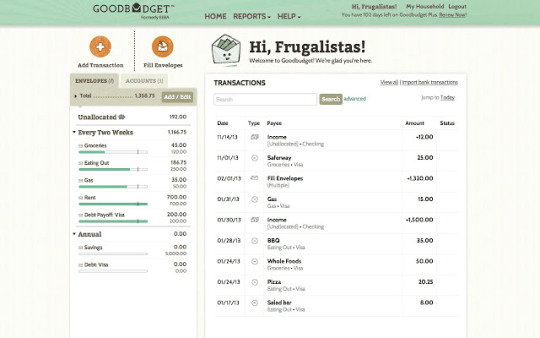
Image Source
4. Claim Your Social Media Accounts
Pre-launch, you’ll want to claim your accounts in social media, and use them actively to generate interest or even early sign-ups, as we’ll discuss more in Step 7.
You can use your social media accounts to showcase the app while it’s in development and solicit feedback and ideas from your future users. When your app launches, though, be sure to change the link in your social media bios to direct to the app store download. Remember, your goal isn’t site traffic — you want to drive downloads.
And don’t discount newer social networks like Pinterest for launching your mobile app — the highly visual social network is the ideal place to show other mobile app developers your product in its final stages who may have some great suggestions for UI/UX improvements. Unless, of course, you’re trying to beat a competitor to market!
Finally, if you’re a HubSpot customer, you can leverage another app — the Facebook Welcome app in HubSpot’s app marketplace — to help with your mobile app launch on Facebook.
Generate some pre-release buzz by customizing a page that lets people sign up for an alert when the app launches. We’ll get into some fun pre-launch deals that will generate buzz around your app that you can associate with this email alert in future steps.
5. Create Content
Spend time creating content that clearly explains how to use your mobile app. This content should include blog posts, press releases, social media content, website copy, and email marketing copy.
You can pre-schedule all of this to go live on your launch day, although you should check in periodically on social media during launch week to provide real-time updates that pertain to support issues, reviews, and respond to user recommendations.
6. Record a Demo
You’ll want to create a video that shows how to use your mobile app — you can easily do this with a user-friendly program like Camtasia that allows screen capture and voiceover recording.
In your video, clearly explain what your app does and why it’s useful in real-life scenarios.
Again, there are so many mobile apps out there, so differentiating yours will come down to clear communication in all of your marketing materials. A short video demo is one of the easiest ways to display the value of your mobile app.
For an example of a fantastic mobile app demo, see CanadaQBank.com’s Mobile App Demo, which shows how the app works, and who it’s meant for:
7. Launch a Dedicated Site or Page
You can launch either a dedicated website for your app — more appropriate if your mobile app is a business in its own right — or simply create a page for your mobile app on your website. The latter is what most companies choose to do.
To complement your social media efforts, you should launch these pages even if your app hasn’t yet hit the market, like how PandaDoc did pre-launch. Direct users to this page of your site, let them view your demo video, and encourage them to sign up for a download alert email once your mobile app goes to market.
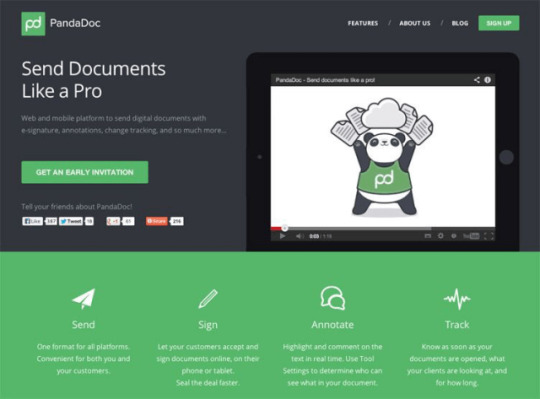
Image Source
8. Choose an App Store
Initially, you’ll want to choose just one app store in which to launch your mobile app. This should help you get the highest concentration of users and ratings possible.
Additionally, you’ll be making lots of changes and improvements to your app during those first few weeks after launch, and having your app in just one store will help you streamline those updates as they roll out. Once your app is more established, feel free to expand it to more app stores.
The most common app stores are the Android Market and the Apple App Store, but there are many other app stores out there (even HubSpot has its own new and improved App Marketplace!). Ultimately, if you’re unsure, do some audience testing to determine which Store is used most by your target market.

9. Use App Store Optimization to Get Discovered
Don’t confuse app store optimization (ASO) with SEO — while both important, you need ASO to get your mobile app discovered specifically within the app stores of your choosing.
Best practices include optimizing your app title with relevant keywords. And when you’re submitting your app to these different app stores, be sure to fill out all the categories most relevant to your app, so users browsing through categories have a good chance of finding you.
Also, you’ll want to include clear screenshots within your app download page that showcase the most common use cases of your app.
In the example below, Todoist uses keywords like to-do lists and project planner. Their app screenshots are also beautifully designed, telling you how you can use the app right away.
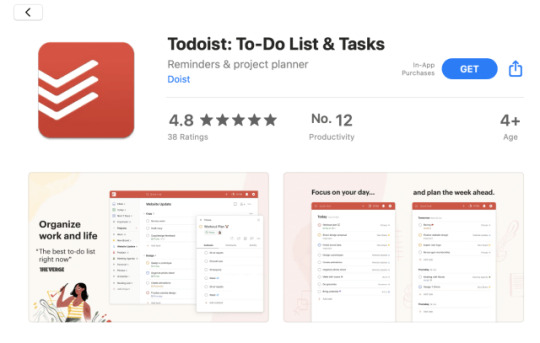
Image Source
10. Network With Other App Developers
Consider reaching out to other app developers that have created an app that could be complementary to yours, and whose users might also like to use your app. You could set up a mutually beneficial co-marketing opportunity that helps you both increase your install rates.
Just be sure to select developers who have great ratings in the app store. You don’t want to associate your app with a bad product.
11. Pitch Your App
Pitch your story to tech, mobile, and industry journalists and bloggers. Be armed with the video demo you recorded, and be prepared to give them a free download of your app so they can get to know the interface and your app’s capabilities. Make yourself readily available to answer any of their questions, and consider them another test group who can find bugs and make UX/UI recommendations.
You should start pitching at least a few weeks in advance so they have time to experiment with your app and write a compelling story without being rushed. Plus, the more time they have, the more likely they can fit you into their editorial calendar.
12. Tap Your Network for Buzz
Reach out to your business network and ask them to share your content about the app’s impending release on their social channels. Send your network a sneak preview email with a link to your demo video so they can see how your app works, and include social sharing buttons to make sharing your content easy.
This is also a great recourse for bloggers and journalists you’ve contacted who aren’t willing to publish long-form content about your app — you can ask them if they’d be willing to tweet a blog post you’ve written about your app, instead.
13. Set Up Paid Advertising
Because of the Google algorithm’s freshness update, you might gain some organic search tractions at your mobile app launch. Complement that search presence with some paid advertising during launch week.
You can also set up paid, targeted ads on Facebook to drive users to your Facebook fan page, where they’ll be greeted with your welcome screen encouraging them to sign up for your mobile app (refer back to Step 4).
Alternatively, you can redirect people straight to your app downloads page so that they can install it on their phones right away. Which strategy you decide to go with may depend on your app.
For instance, if your app requires some explanation or is fairly innovative in its approach, you can direct users to a dedicated landing page. Meanwhile, apps that users are already familiar with, such as gaming apps, can have ads that take users straight to the app download page.

14. Tap Influencers or Industry Thought Leaders
Influencer marketing is only growing in 2020, so if you want to spread the word for your app, we can’t emphasize this step enough.
Look for different social media influencers, bloggers, and content creators who can help generate buzz for your app before it launches. Choose influencers whom you think will benefit greatly by using yours, and conduct personalized email outreach marketing to effectively build relationships and win them over.
For instance, if you’re launching a mobile app for weight loss, tap different fitness influencers who talk about workout regimes or macro-tracking — whichever features your app has.
15. Launch an Invite-only Beta
Before you take your mobile app live to the public, consider an invite-only beta launch. Websites Spotify, Google+, and Pinterest have used this tactic with great success. It not only creates an air of exclusivity that generates buzz around your product, but it also lets you get feedback from a trusted network so you can fix bugs and UX/UI problems before rolling your app out full scale.
You can use the email list referenced in Step 4 as your pre-launch beta test group, and supplement it with an email marketing send to a segment of your current customer list that would benefit from using your mobile app. You can position the launch as the opportunity for free, exclusive access to your mobile app before it launches, and even ask them to write a review of your app in exchange for that free, exclusive access.
Alternatively, you can use TestFlight to launch a beta version of your app and invite users to give it a test run until your official launch.
16. Partner With Affiliates to Promote Your App
We’ve mentioned influencers and industry thought leaders in Step 14, but you can take your partnership the extra mile by creating an affiliate program to encourage downloads or purchases.
Identify key influencers — these can be media contacts or social media influencers with bigger followings — whom you can incentivize for pushing your app. Give them a special link that tracks purchases or downloads, so they automatically get instant rewards when their audience does a desired action.
17. Put Download Links Everywhere
Congrats — you’re officially ready to go live to the public!
You’ll want to put links to download your mobile app on your blog, your website’s home page, in your marketing emails, and on your social media accounts — you can even add a mobile tab to your Facebook page.
For instance, take a look at Waze app page below, which includes three calls-to-action above the fold, all of which are to download the app:
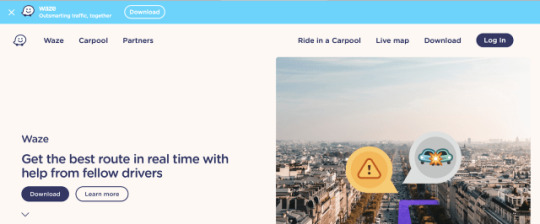
Image Source
18. Have a Launch Party
A launch party doesn’t have to be anything big. In fact, you can have a small intimate digital launch party through a webinar. Invite early adopters, influencers, tech journalists, and others to take part in a short launch.
You can announce special live discounts or perks while giving attendees all the details they need to download your app or spread the word.
Below, developers of Summerian announced a launch party happening on Product Hunt, while giving interested users a peek of what to expect during the launch:

19. Monitor Feedback and Encourage Reviews
Finally, you’ll want to monitor peoples’ feedback about your app, and strongly encourage users to post reviews.
It’s not just that the apps with the best reviews get the most visibility and downloads — this process also helps you identify bugs you wouldn’t otherwise know about and make quick changes to improve the user experience and make your app stickier.
Keep users updated on your progress as you make it so they know you’re listening and responding to their feedback, and take a look at Steps 21 and 22 if you want to take this even further while involving and updating users on new features and updates.
20. Identify Potential Integrations
The average smartphone user has between 60 to 90 apps on their phones, and you might have noticed some apps integrate with one another — for instance, you can log into your account on Pinterest using Facebook, or integrate your native Health app with your calorie counting app or fitness tracker.
This is more convenient for users, and best of all, you can increase retention when you integrate seamlessly with apps your users already have.
In HubSpot App Marketplace, for example, you can find all the apps that integrate with HubSpot seamlessly. Get to know who the developers for these apps are and strike up a partnership. You’ll never know how many doors these app integrations can open for you.
21. Publish an App Update Log
Transparency is becoming a very important thing for consumers, and one way to be more transparent with users about your mobile app is to keep them up-to-date with any changes and features over time.
An update log is the easiest way to do this. Send these logs to your app store pages, and even have a dedicated update log page on your website for users to easily see changes you’ve implemented the past several weeks.
By keeping users updated with your app changes, you can also increase retention rates as users see different updates they might have been waiting for or may benefit to learn more about. If an update is particularly big — such as a big interface change or even an exciting new feature — you can send push notifications and in-app pop-ups for users to see a breakdown of these new features on a dedicated page on your website.
Sometimes a brand will even inject their personality into these app updates. Just take a look at one of Medium‘s app updates from 2016:

Image Source
22. Keep a Hub of ‘Coming Soon’ and ‘Wishlist’ Features
If you want to let users know you’re listening to their suggestions and feedback like we mention in Step 19, then you can create a hub of your Coming Soon or wishlisted features.
Loom is a great example of a software app that does this. While they’re not a mobile app, the way they keep users updated with features that are coming soon or may be considered for development is a great way to keep your current customers on your app.
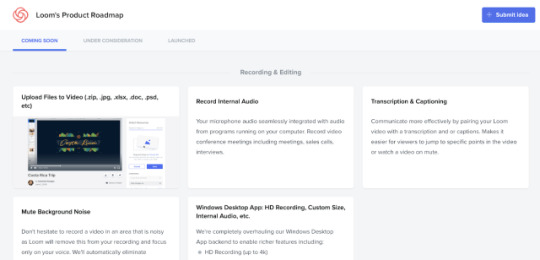
Image Source
Create a button or page on your mobile app that lets people submit feedback or requests for new features. Once they’ve submitted their thoughts, you can send them to this Coming Soon hub so they see all the exciting things you have in the works. They’ll be much more likely to stay on board to see these features come to life, and you’ll be increasing your retention rates and customer loyalty in the long run.
To help you manage your updates and still keep your app running for users, it’s best to use a NoSQL database, considering its popularity for helping mobile app developers worldwide manage their apps in a more streamlined way while lessening downtime for users.
Launch Your Mobile App the Right Way
Are you ready to launch your mobile app this year? Simply follow the steps above to make sure you’ve got everything covered for your launch, while making sure you can keep users around for the long haul. I’m excited to see your app come to life.
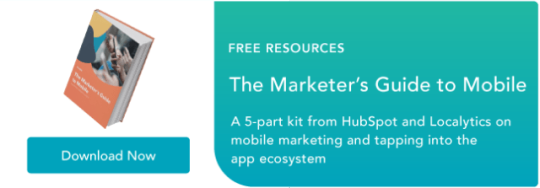
Source link
Tags: 2020, app, Complete, Guide, launch, Mobile
from WordPress https://ift.tt/3cGGfaD via IFTTT
0 notes